
Contents
Document 1
This Insights Report sets out the potential value associated with employment in remote communities. An accompanying data tool provides a
basis for the NIAA to further estimate the returns to employment outcomes across remote contexts, over time.
Reflections on the value of remote employment outcomes
3
3 | What is the distinct value of outcomes in the regions, and what
21
An overview of the key themes that emerge in this report – about how the
does this imply about maximising returns to the RJED?
value of remote employment* can be understood and measured, and the
An approach to assessing region-specific program outcomes, in lieu of
implications of these results for the design and impact of the RJED program.
region-specific program data, and a discussion of program levers to
maximising program returns.
Key Findings
4
The high-level overview of quantitative benefits estimated as part of this work,
for a part time job created through a notional employment outcome.
Appendix A | Modelling assumptions and guide to using the data tool
26
Background and context
5
The context and motivation for the program and this work, including
Appendix B | Considerations for key assumptions and future
31
background to the initial phase of work, an overview of the three underpinning
refinements to estimating quantified benefits
analytical components, and guidance to interpret the results presented in this
document.
References
33
1 | What are the potential benefits associated with remote employment
10
outcomes?
Agency under FOI
The insights and findings from a detailed literature review, including a
comprehensive list of benefits and benefit types associated with employment
programs.
Australians
2 | What value is quantifiable with respect to regional and remote
16
Indigenous
employment outcomes?
An overview of the analytical modelling approach to and the results from
* This report refers to remote employment outcomes for consistency with the naming of the
estimating the quantifiable benefits to employment programs.
Remote Jobs and Economic Development program. It is noted that when measuring the
remoteness of populations in the CDP regions (using an ARIA concordance); the outcomes are
primarily in remote and very remote areas, though others are in outer regions. Page 20
by the National
provides more detail about the regionality of
CDP Trials participants.
© 2024 Deloitte Access Economics. Deloitte Touche Tohmatsu
2
FOI/2425/085
Released
Foreword: The value of employment outcomes in regional and remote communities(1/2) Document 1
This report estimates and describes the economic benefits that can flow from regional
While considering financial returns to employment for individuals, government and
and remote job creation.
This includes an estimate of the quantifiable benefits likely to be businesses; through value associated with 13, 26 and (where transitions persist) 52-week
associated with employment in regional and remote communities; using the available
placements, this report’s modelling framework draws the implication that maximising
outcomes from the
CDP Trials to consider the potential value of the
Remote Jobs and
returns from 52-week-placements would be achieved by directing placements to the
Economic Development (RJED) program.
highest earning industries (roles or occupations). It inherently focuses on what is termed
But this project – and critically the RJED – is about much more than solving for short-term
financial and produced capital. Whether this approach maximises value over the long
economic return.
It is about outlining the way we might reimagine economic
term depends on assumptions about whether placements across different industries are
self-determination, community infrastructure, and meaningful employment opportunity.
equally likely to endure as lasting employment, and whether those roles contribute to
Speaking plainly, it is about understanding employment possibility for Indigenous
systemic opportunity and
scale. That is, whether those roles add value to
social, human or
communities from the ground up, rather than from government down.
cultural capital.
In my culture, work means something.
For instance, research on employment benefits finds that outcomes rely on employment
transitions being sustained and suitable for participants, suggesting a placement into the
It is measured in intrinsic reward as much as extrinsic. It is for community. It is meaningful.
most culturally-suitable work may be more likely to be
sustained, while systemically
It is not something measured only in income or time or position.
significant roles are more likely to contribute to whole community growth.
It is measured in the contribution to family and community and the system we share.
To inform how the NIAA uses these findings in an investment framework for the RJED,
this report considers trade-offs in maximising program value, including:
The normal metrics of economic frameworks are informative but ultimately too narrow to
properly diagnose problems or generate systemic, structural, long-term solutions.
• Whether a longer-term approach to maximising returns might direct focus toward the
dimensions of
meaningful work for participants and lead to enduring outcomes.
In this project we attempt to describe them more completely, using the sophisticated
capability of Deloitte Access Economics and innovative frameworks of thinking about the
• The role of employment programs in
addressing systemic barriers to economic
Agency under FOI
way community wants to build, and wants to work. Reflecting on the jobs trial, this
participation, by investing in other employment-related supports (training programs,
project considers how the RJED can create value by investing in community capability –
drivers licenses); a feature of many CDP trial trials. These activities may not generate
so that services are
delivered by community rather than merely to community.
immediate returns but can be essential preconditions to enduring employment.
Australians
This Insights Report provides a foundational framework and a new data tool to quantify
• The
equitable distribution of placement opportunities across the community;
benefits associated with employment placements in that program. While the TPRJ
recognising that the demographics of program participants (age, gender, Indigeneity),
Indigenous
program consists of initiatives that support short and long-term remote employment
and the accrual of benefits from that work to local community may vary across the
objectives, our focus on evidential analysis and the truth of present data limitations,
industries or type of work supported, including whether that work is culturally
requires that this report primarily focused on what can be quantified in the near term
appropriate, or located in proximity to community.
using traditional measures of economic participation.
continued over page
by the National
© 2024 Deloitte Access Economics. Deloitte Touche Tohmatsu
3
FOI/2425/085
Released
Foreword: The value of employment outcomes in regional and remote communities (2/2) Document 1
The findings in this work reiterate the value of investments that can
Scope of this work
complement the RJED’s focus on labour supply by
building the capacity,
This report is designed to support the NIAA to better understand the potential value of regional
resilience and suitability of the demand side (local employers). This
employment outcomes, and thereby to aid the NIAA’s understanding of the potential value of
includes building the cultural competency of non-indigenous employers and
employment programs such as the CDP Trials, and in time, the RJED. Page 5 sets out the high-level
the capacity of Indigenous business to benefit from engaging with public and
approach, key findings and implications associated with the findings.
private investors and measurement frameworks.
The findings presented in in this report present estimates of quantifiable benefits associated with
The findings in this report also highlight that some RJED employment
regional employment outcomes, calibrated to the profile of an ‘average’ CDP Trials placement
outcomes might result in the displacement of some workers (where funding is
outcome, across regionality and industry. Considerable further data col ection, analysis and
used to fill existing local jobs). However, this aligns with the policy objective
evaluation would however be necessary to determine the net return on interventions such as RJED.
of local job creation where it is indicated that out-of-community workers are
Interpreting the estimates
being replaced by in-community workers.
Importantly the figures outlined in this report do not represent estimates of the benefits associated
This finding also reiterates the relatively thin employment markets where the
with a specific employment program or trial. The estimates also do not reflect the application of a
RJED operates, which in turn encourages a focus on maximising value by
cost benefit analysis (CBA) framework to model the net effect of these programs. Rather, the analysis
ensuring an investment in the economic development and capability of local
is highlighting the potential value of the intended outcomes under a number of necessary
economies over the long-term through public investment rather than the
simplifying assumptions:
simpler targeting of net returns from job creation in the short-term,
• Employment outcomes reflect employment for jobseekers in ‘
newly created jobs‘. In an
Against that context, this work reinforces that a broader framework to
alternative case where outcomes reflect employment in existing local jobs (or jobs that would
understand value is essential to achieve those objectives in an enduring way –
have been created anyway), effects like the displacement of other workers would need to be
this report contributes the ‘six capitals’ framework to that discussion and
accounted for. A sample of data on employment outcomes from the CDP trial trial suggests that
Agency under FOI
concludes with a series of implications for future data collection and analysis
the program is primarily resulting in newly-created jobs.
to support that intent.
• This report’s estimates do not include
the costs associated with ongoing funding of remote
This framework points to the conclusion that in the absence of a net short-
employment programs. Nor does the estimation include other potential costs such as opportunity
Australians
term return in employment terms, investments which build any of the capitals
costs for businesses or individuals (including the cost of foregone leisure time).
can support economic growth; because these endowments are predictive of
• Employment outcomes are assumed to be achieved by
individuals who, in the absence of the
economic advancement.
employment programs, would be unemployed and receiving income support payments.
Indigenous
• The downstream economic and social impacts have not been calculated in this work, though the
Professor Deen Sanders OAM
literature review highlights several downstream benefits in qualitative terms. A net return
Worimi Man
estimation would require estimates of
downstream economic impacts and social benefits
Deloitte Access Economics Partner
(both positive and potentially negative).
by the National
© 2024 Deloitte Access Economics. Deloitte Touche Tohmatsu
4
FOI/2425/085
Released
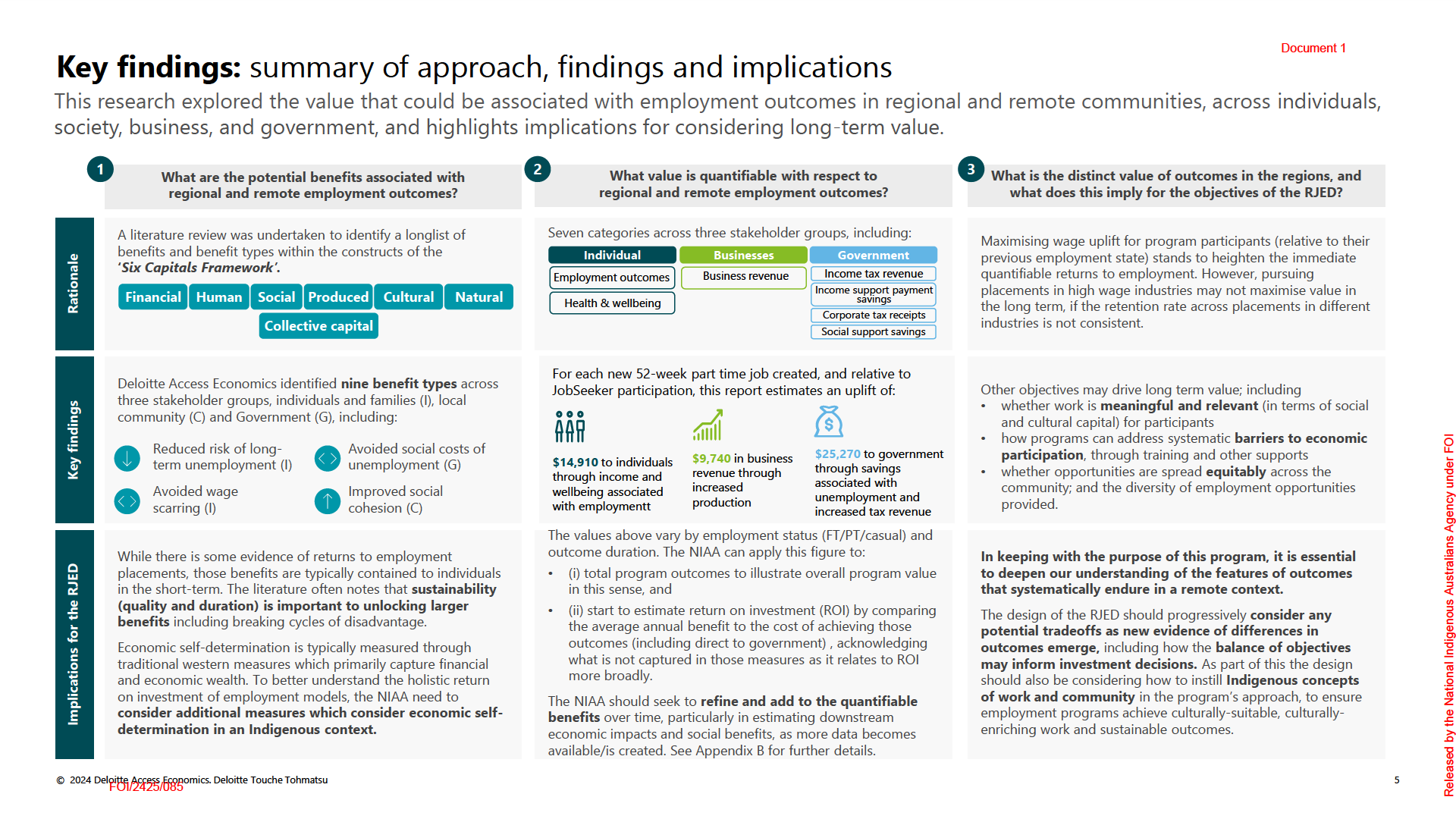
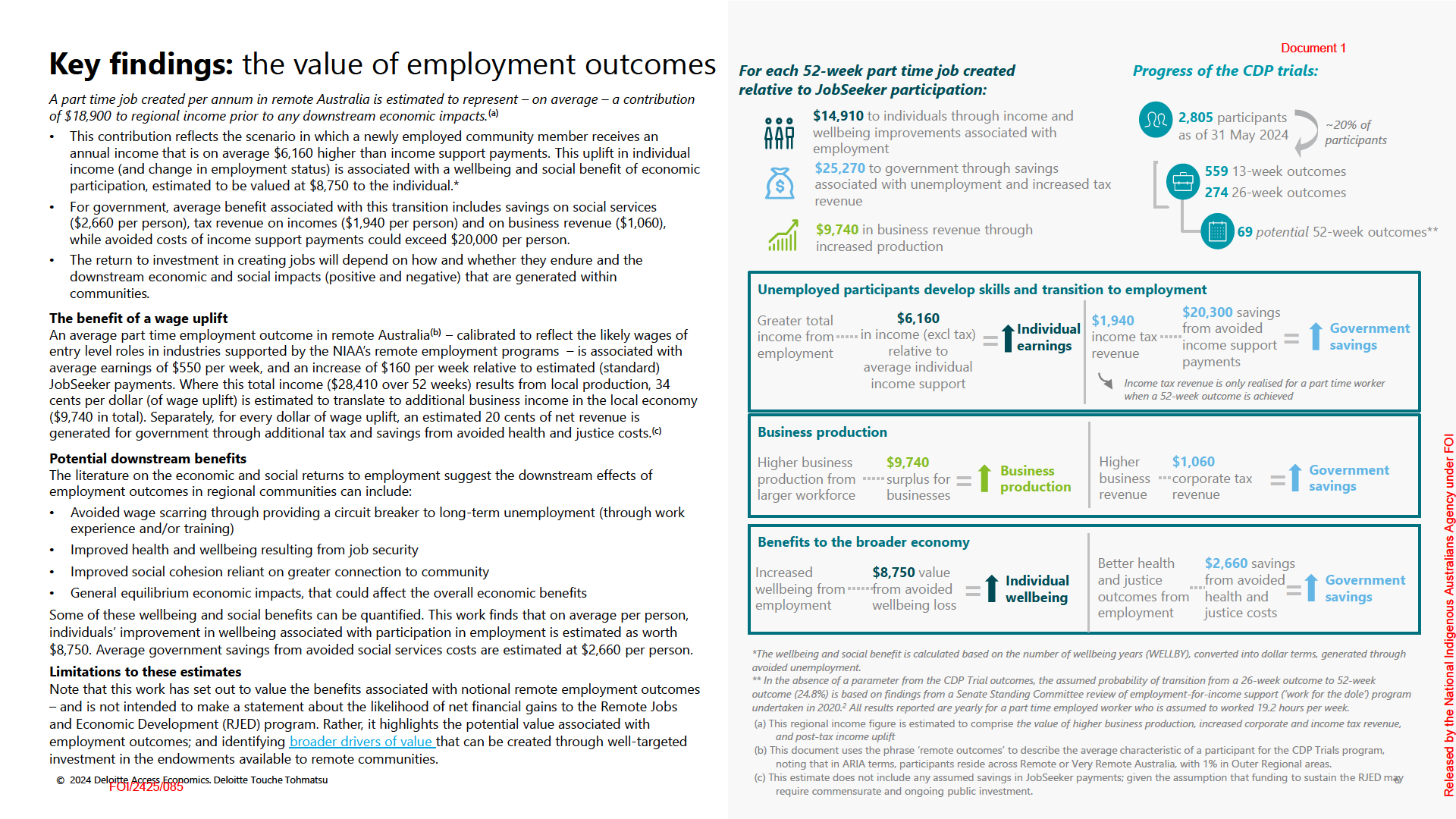

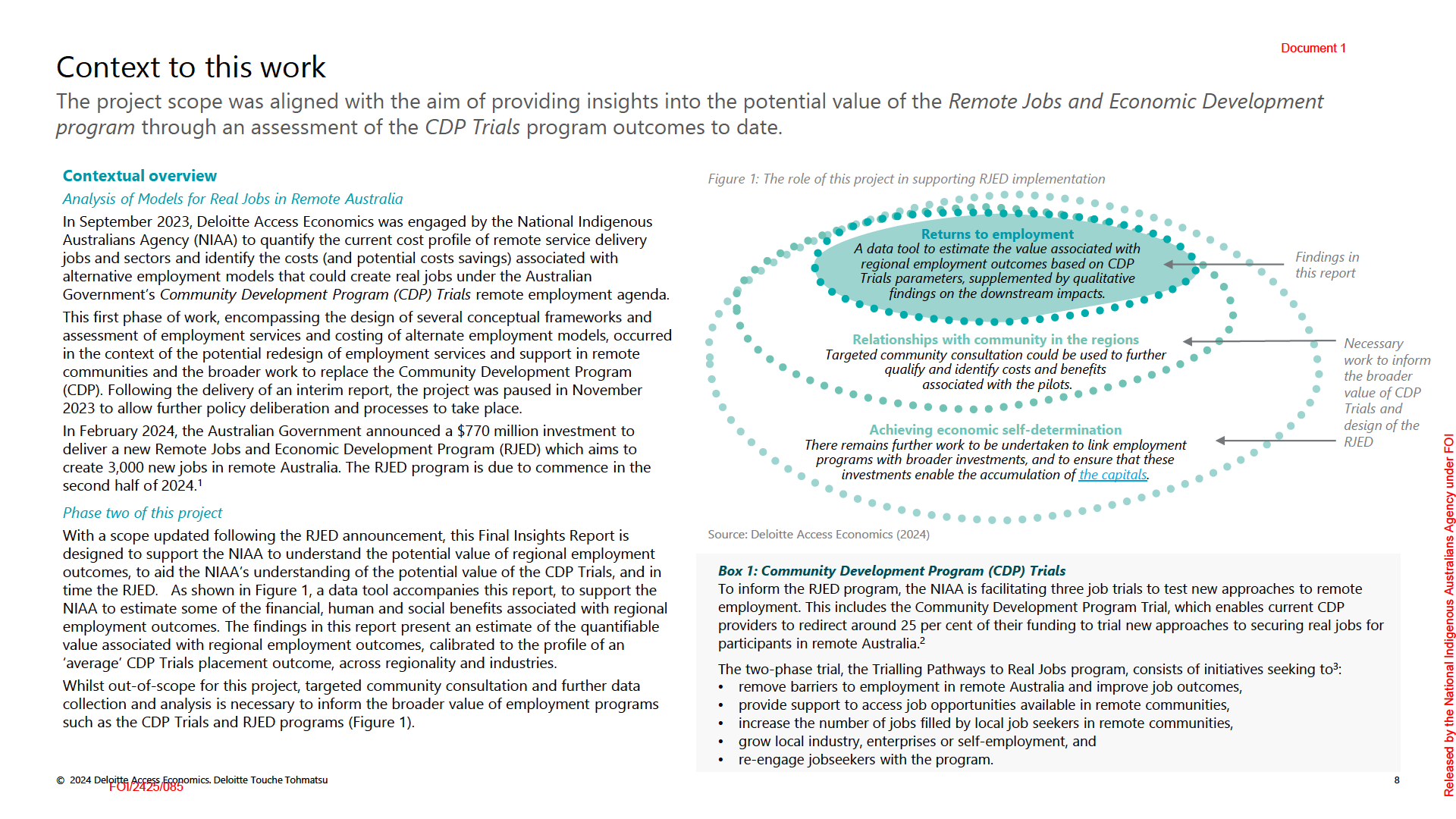
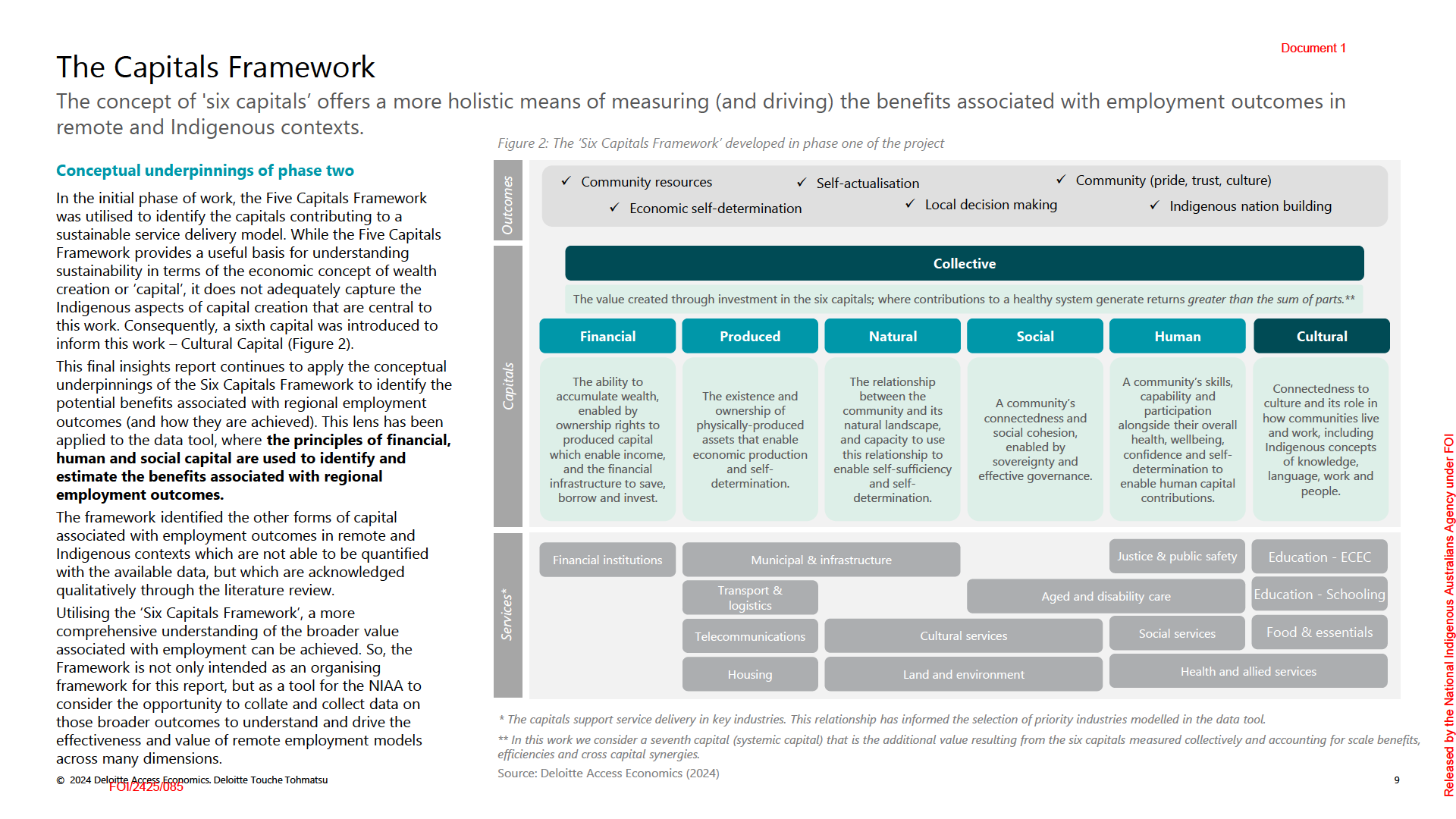
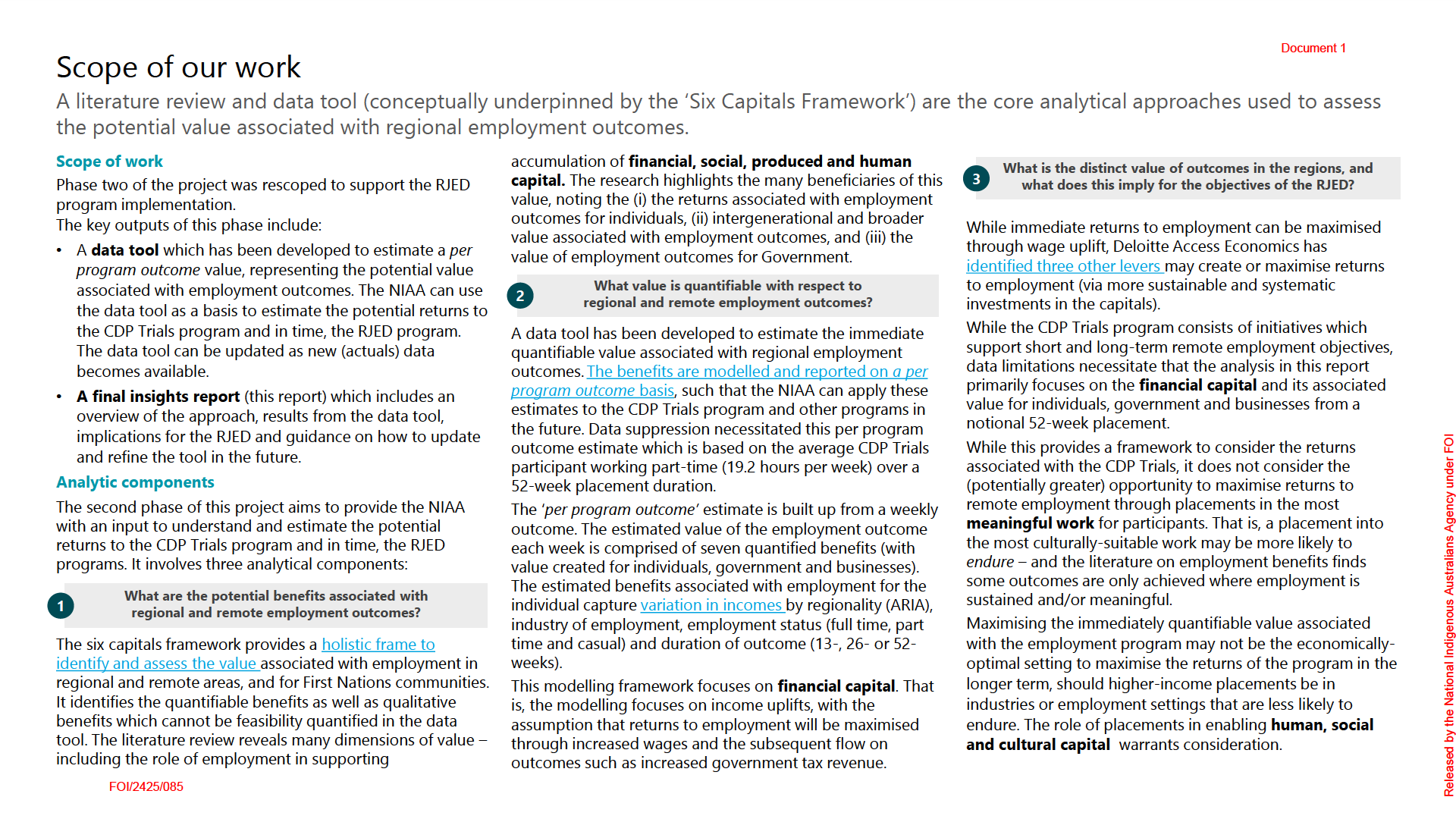
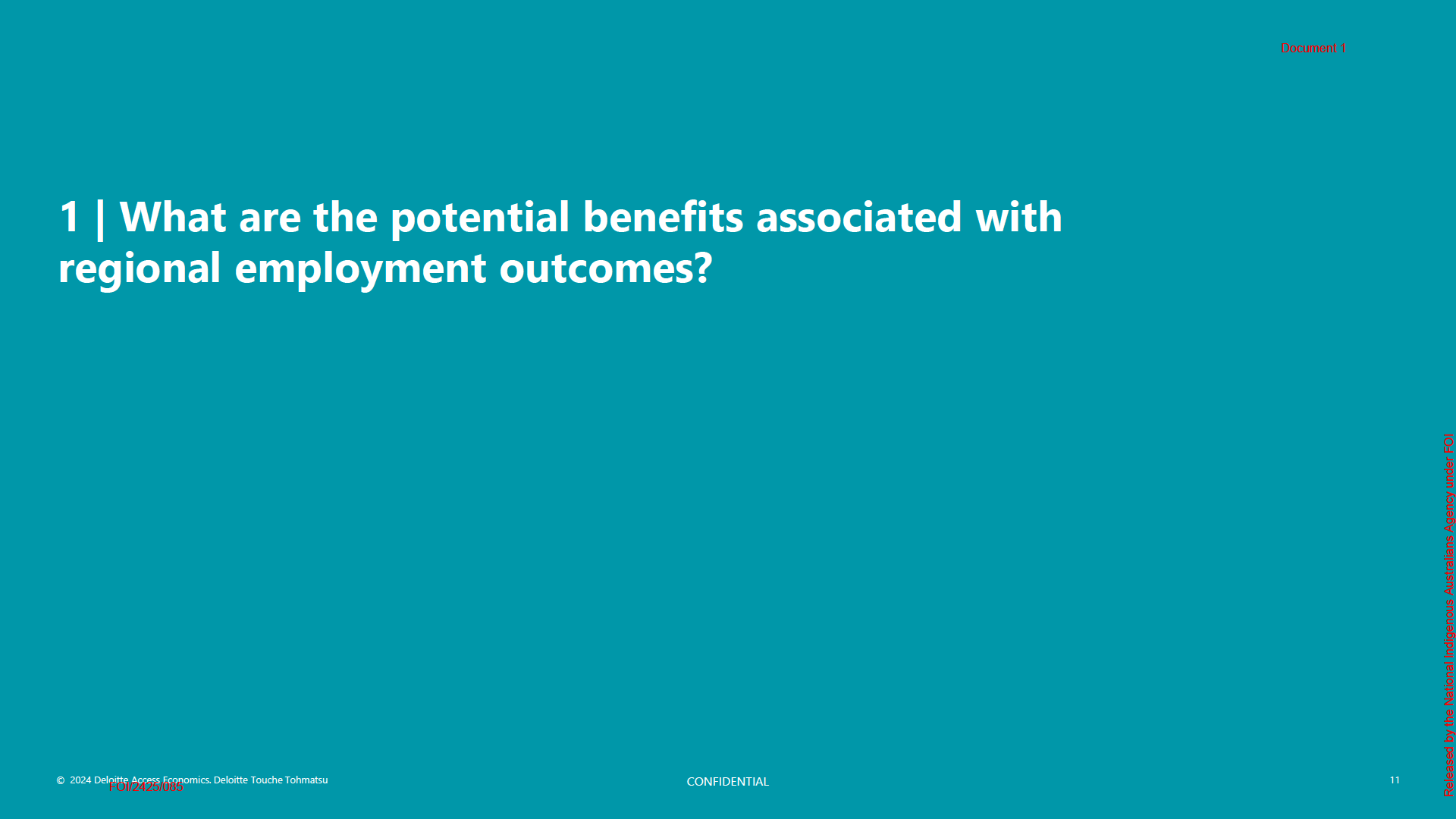
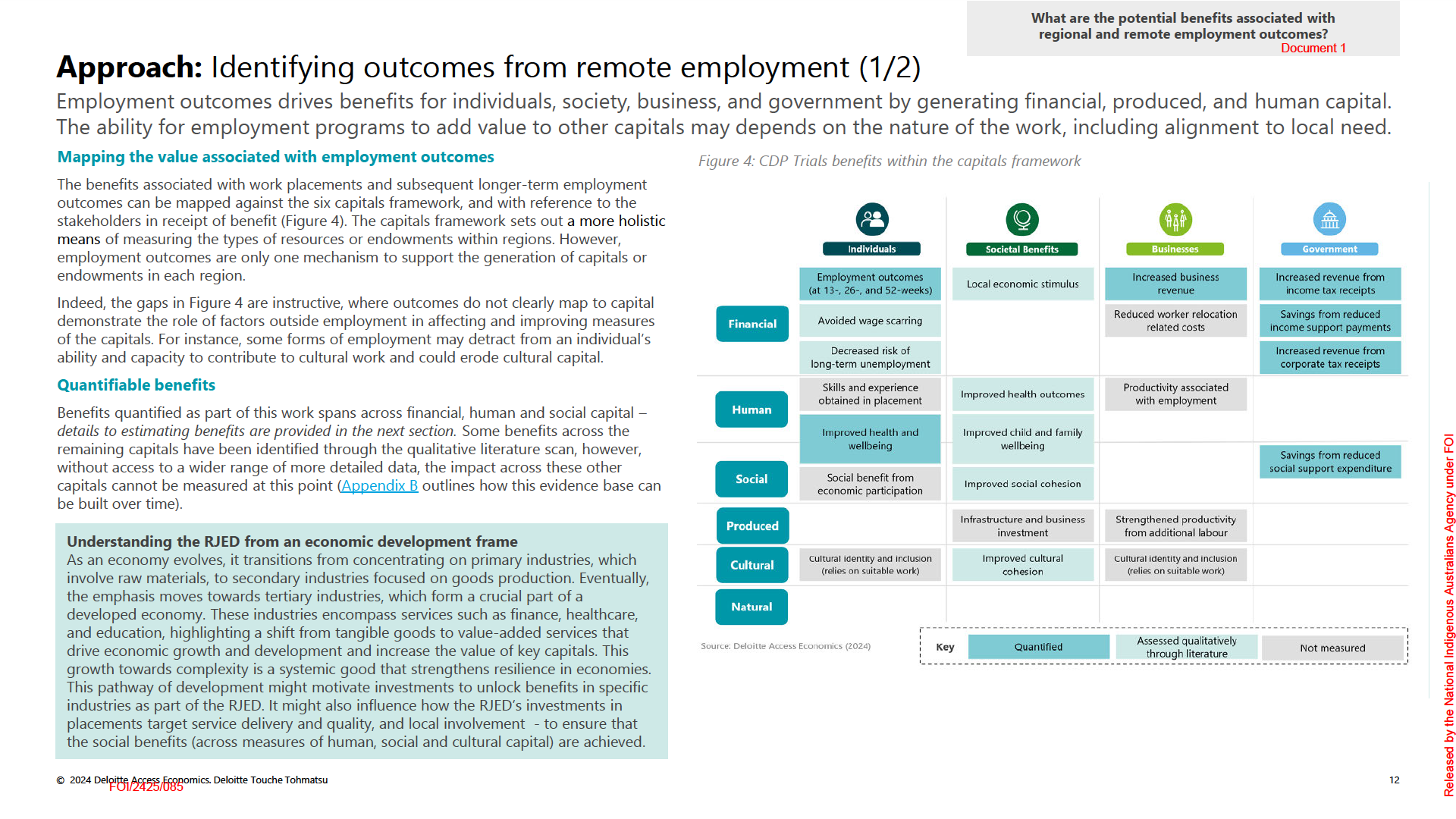
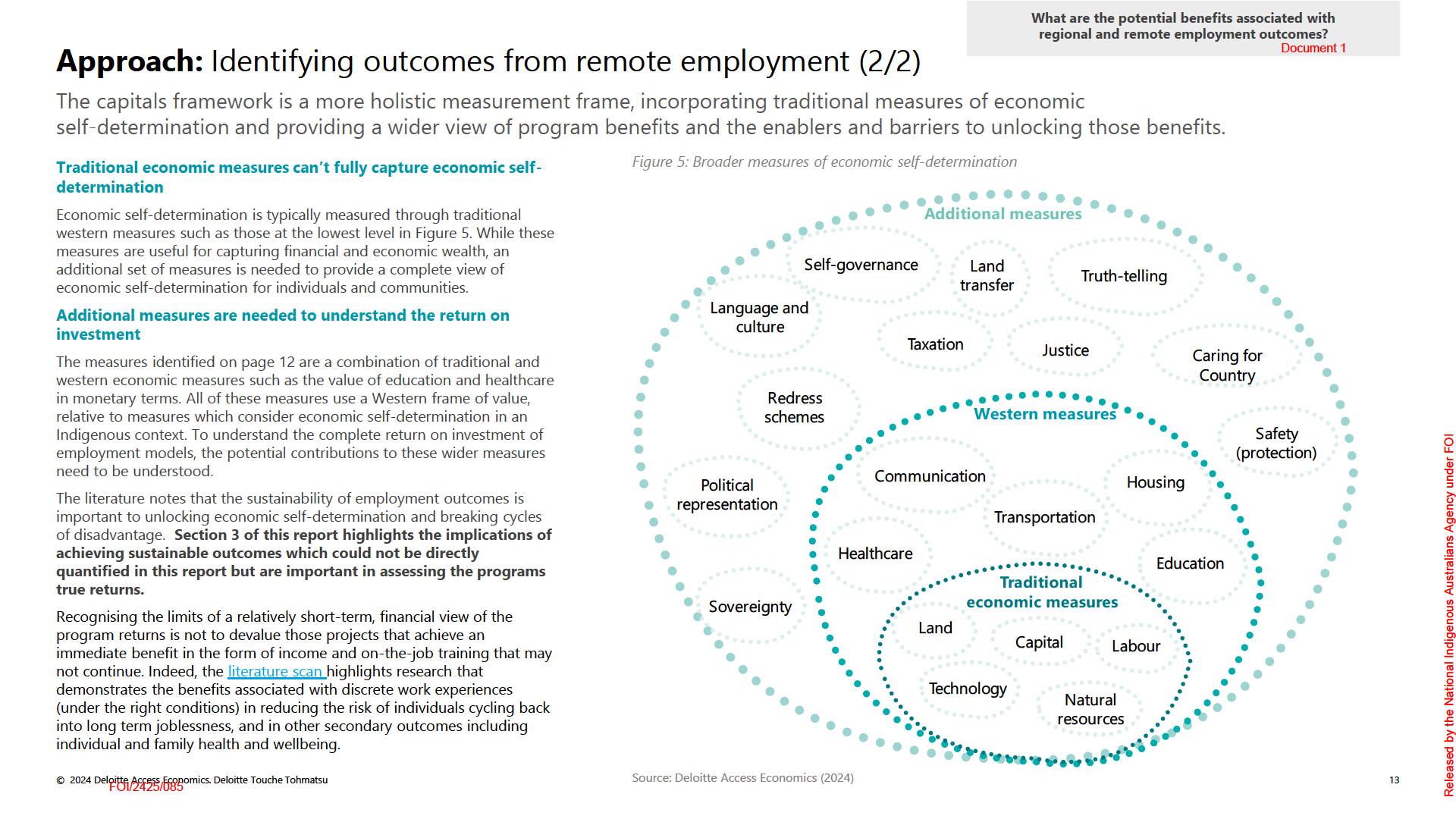
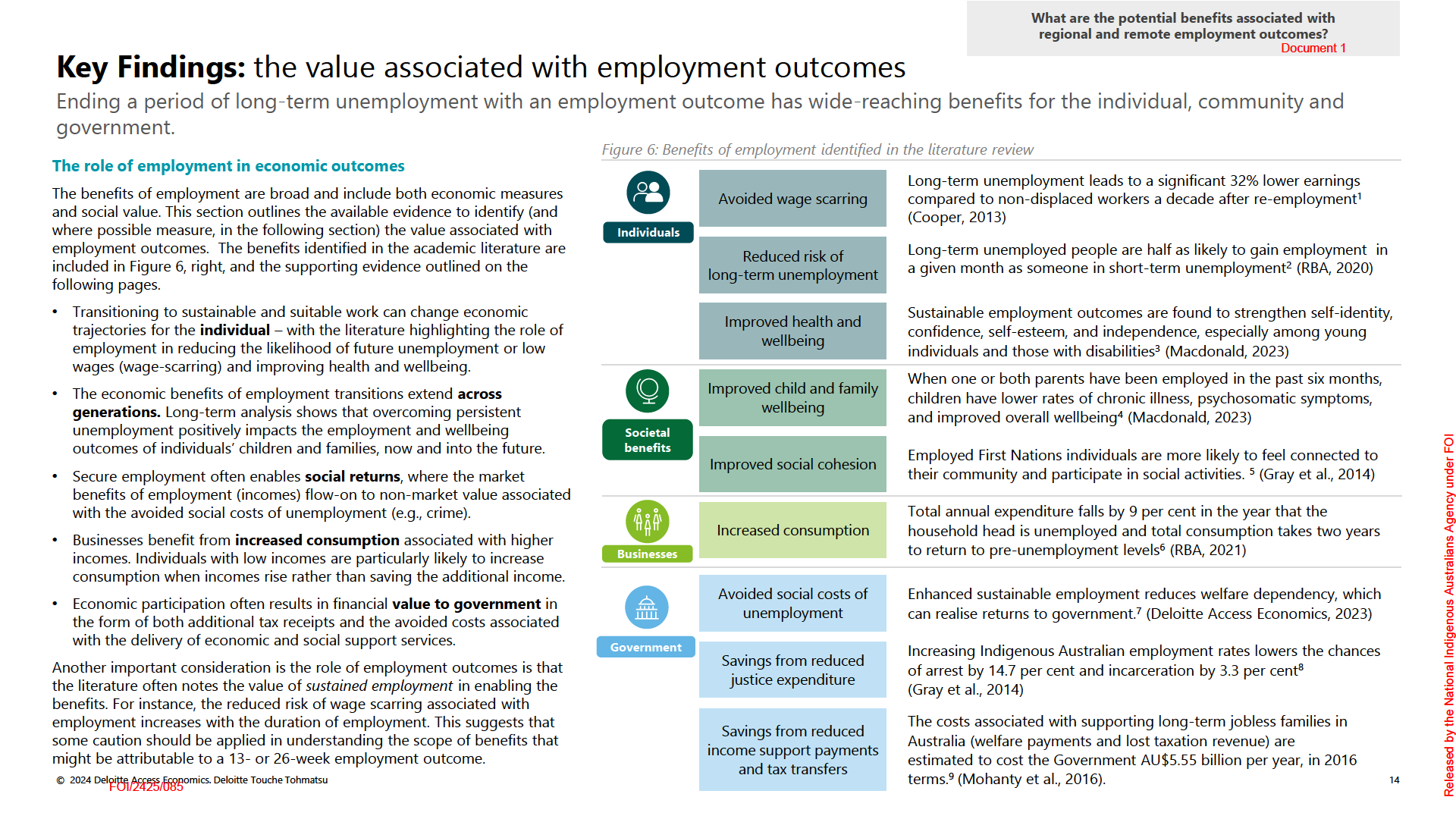
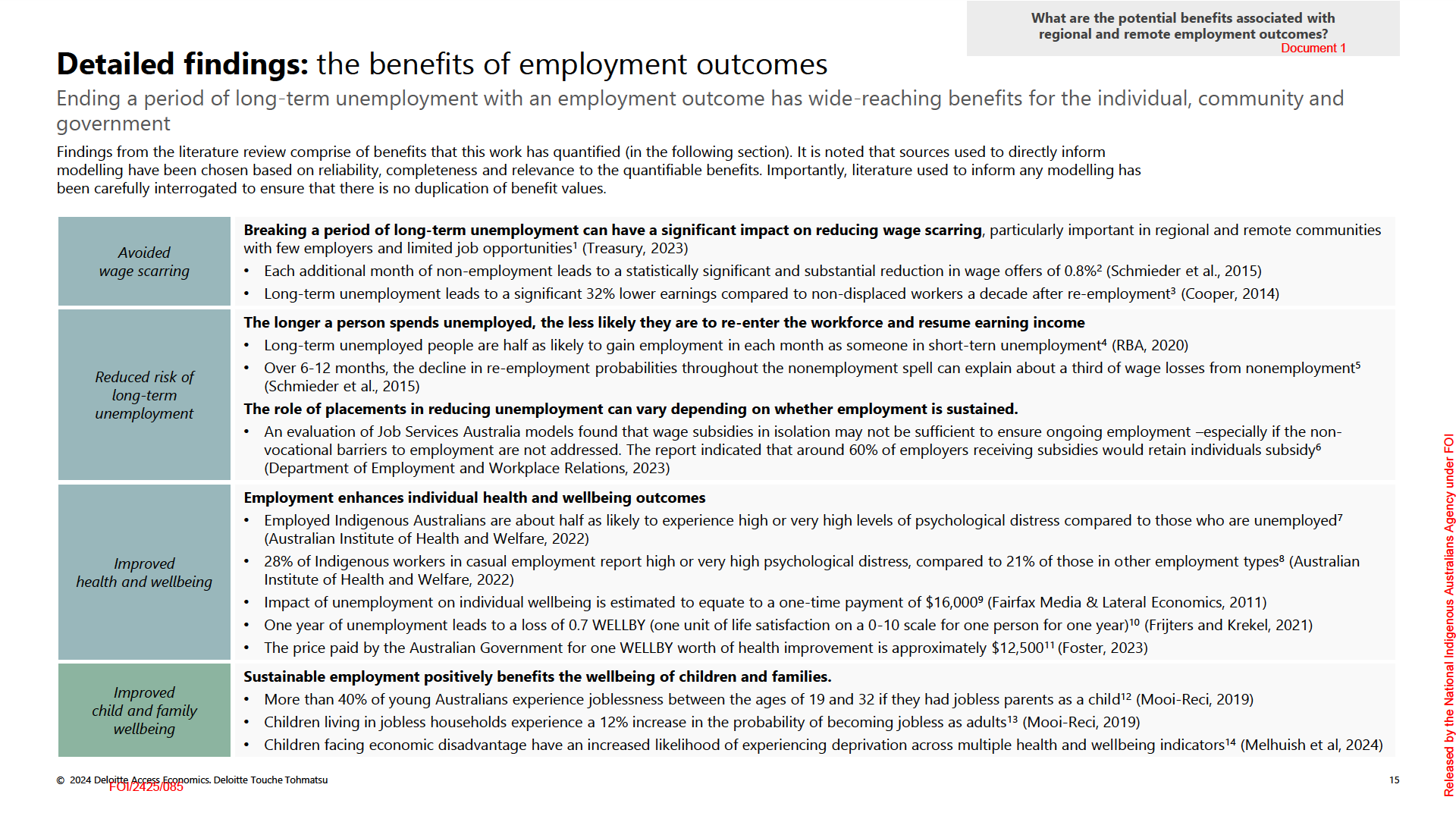
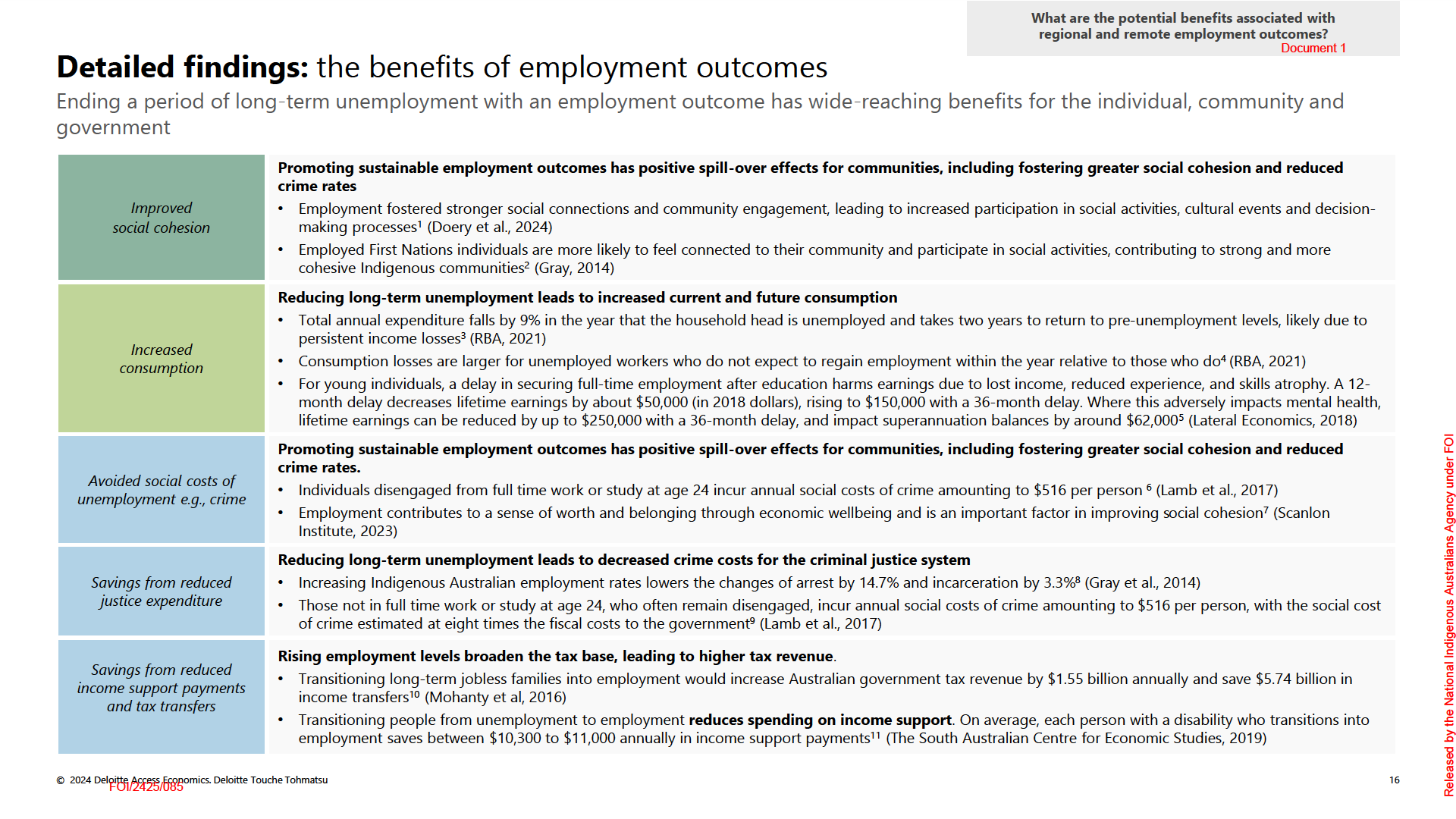
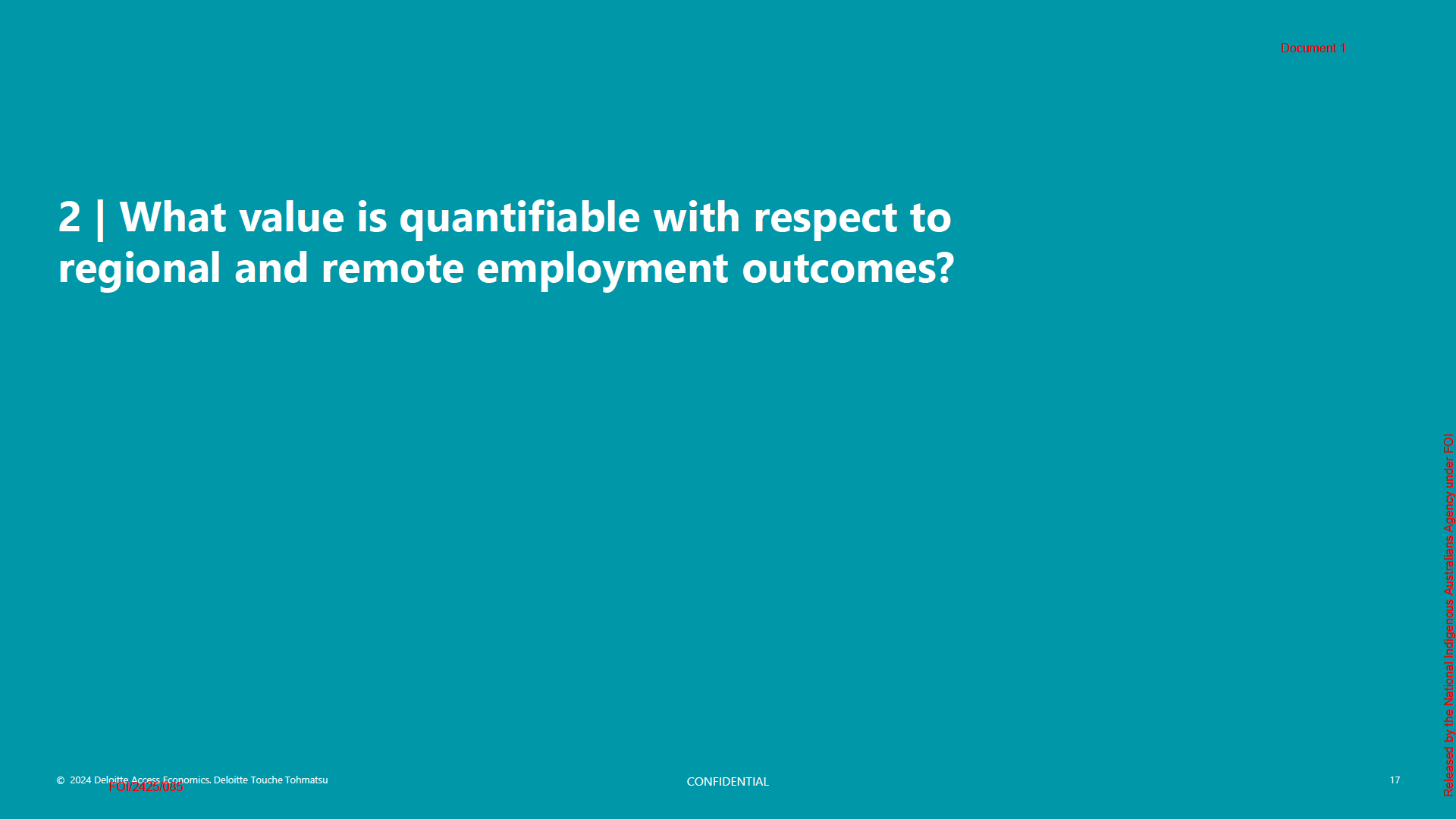
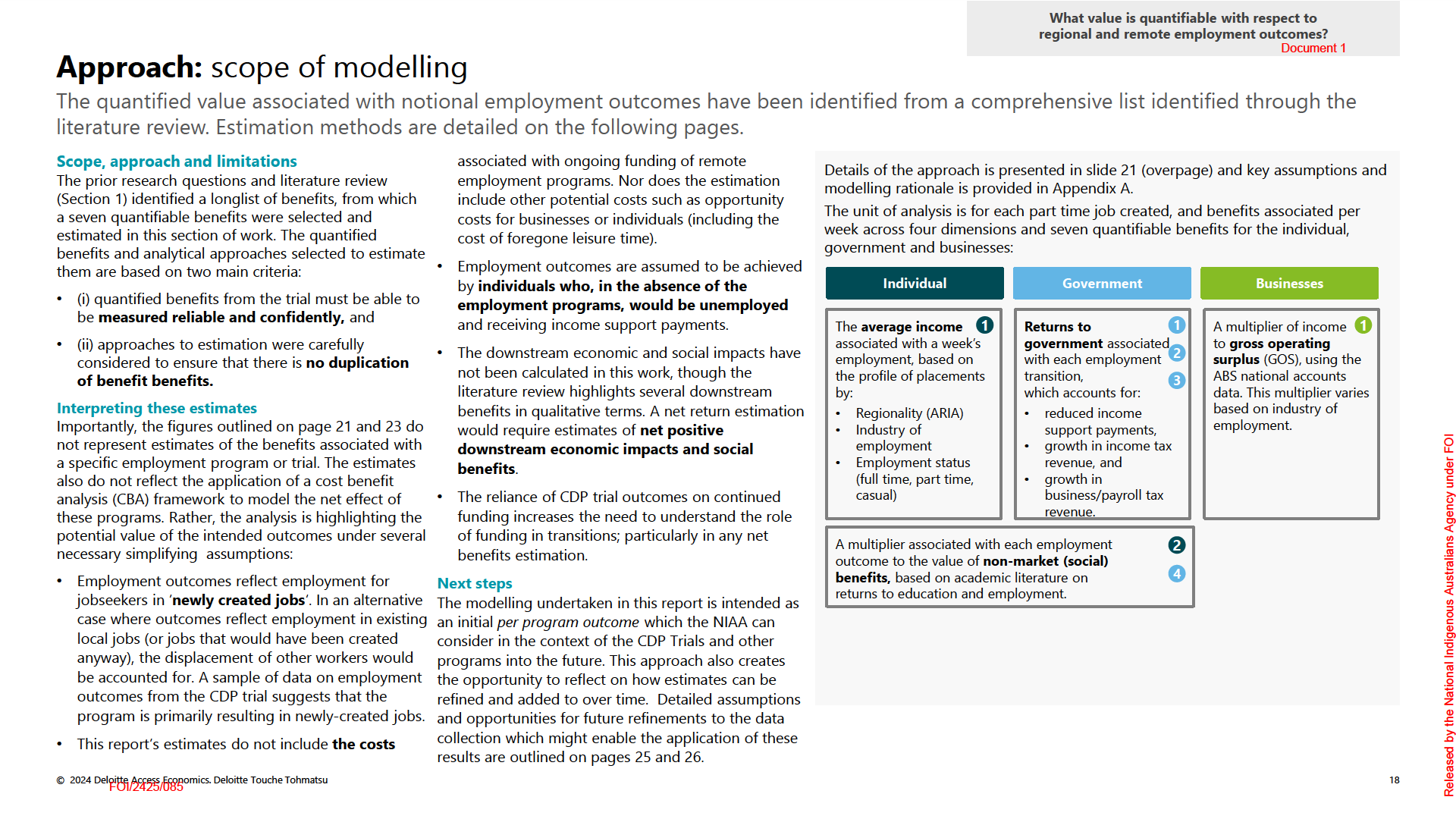
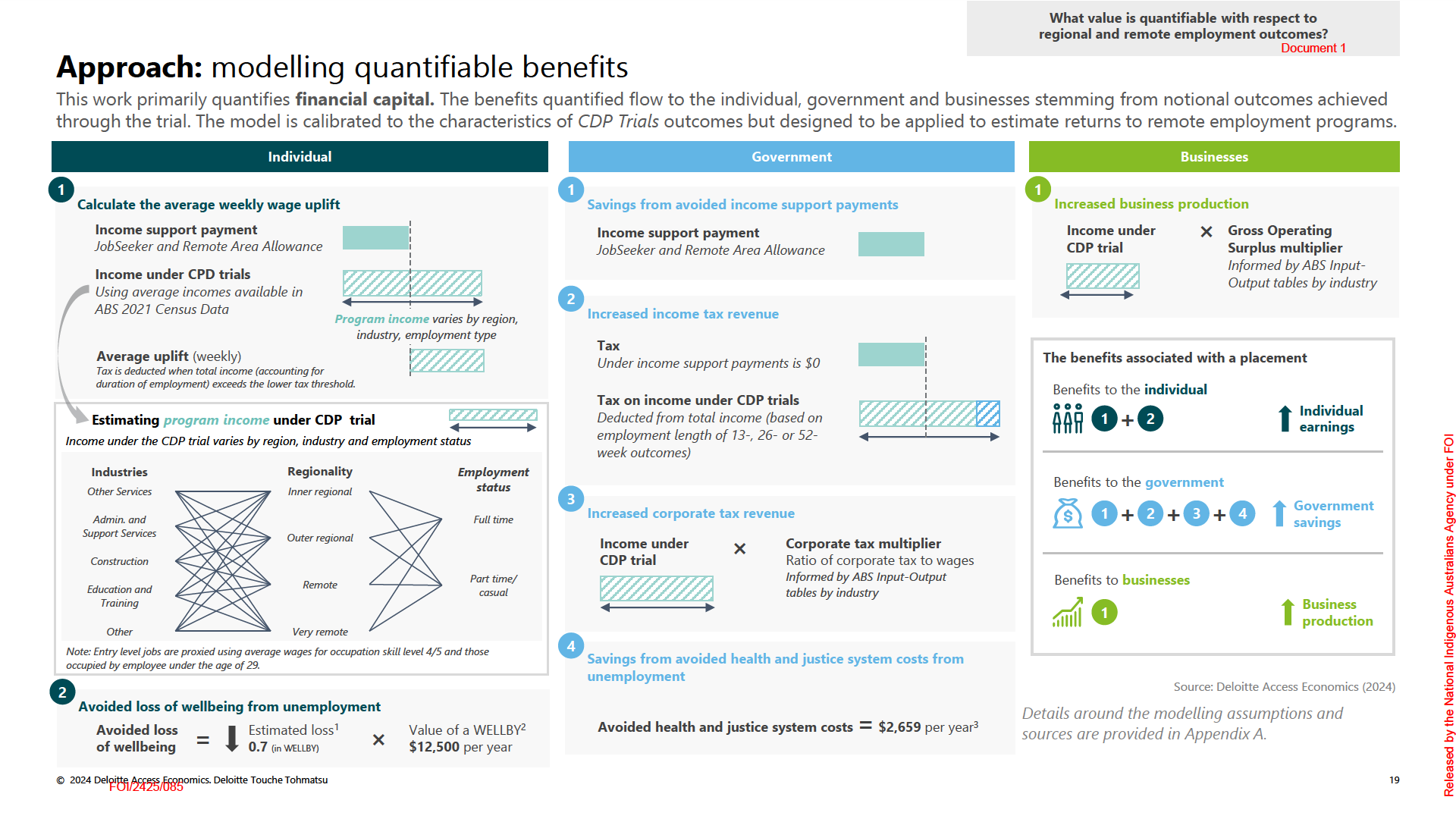
What value is quantifiable with respect to
regional and remote employment outcomes?
Key findings: modelling and program outcome results
Document 1
Quantified benefits reflect regional variation, industry, employment status, and outcome duration, calibrated to the profile of participants in the
CDP Trials, but are designed to be generalised. The accompanying model allows for the parameters to be adjusted.
Key findings
Profile of the CDP Trial outcomes
The quantified benefits and modelling captures the variation in regionality (ARIA), industry of
Between FY22-24, there were a total of 2,805 CDP Trials participants, of which 559 achieved
employment, employment status (full time, part time and casual) and duration of outcome
13-week outcomes and 274 achieved 26-week outcomes.
(13-, 26- or 52-weeks). The
per unit results are reported consistently in this document for a part
time job over a 52-week placement duration and is calibrated to reflect the profile of a CDP
The trial created work experience and jobs in the most remote and regional areas, with 99%
Trials participant across regionality and industry of employment.
of outcomes in Remote and Very Remote Australia.
Chart 1: Profile of 13- and 26-week outcomes by regionality
Deloitte Access Economics estimates that for every part time job created through the
Very Remote Australia
trial, a contribution of $18,900 to Gross Regional Product (GRP) is created.
86%
Remote Australia
13%
An average job outcome sees an $9,740 in the annual value added to the local economy, and
Outer Regional Australia
1%
results in 20 cents to the dollar in improvements to government finance through additional tax
and reduced income support payments.
Source: Deloitte Access Economics (2024) using NIAA program outcome data. Note: CDP regions have been mapped to ARIA
regional categories based on the proportion of caseload in ‘Very Remote’ regions (NIAA remoteness index).
Other downstream effects for communities include avoided wage scaring and improved
Greater visibility of occupation industries would improve the ability to capture variations in
wellbeing; with evidence pointing to the intergenerational benefit of addressing joblessness.
program outcomes – 51% of outcomes are in
Other Services and 19% in Other industries.
The value of employment to the local economy (in GRP terms) equates to:
Chart 2: Profile of 13-week outcomes by Industry
• $4,700 for an individual with a 13-week outcome, which 559 trial participants have achieved,
Other Services
284 (51%)
or
Administrative and Support Services
70 (13%)
Education and Training
• $9,500 for an individual with a 26-week outcome, which 274 trial participants have achieved.
37 (7%)
Agriculture, Forestry, Fishing
34 (6%)
Agency under FOI
This modelling demonstrates how value could be created when 13- and 26-week outcomes
Health Care and Social Assistance
27 (5%)
persist to a years’ employment. It is notes that data provided by NIAA for a sample of 15
Other industries*
107 (19%)
regions finds only two instances where a substantial share of jobs created under the CDP Trials
Source: Deloitte Access Economics (2024) using NIAA program outcome data. *Note: There are 107 outcomes in the
would be “sustainable without continued funding and support”. In most instances where jobs
Australians
remaining industries with unknown shares due to data suppression.
filled under the CDP Trials are reported as likely to be sustained, these placements appear to
All program outcomes are in casual (90%) or part time (10%) roles. The longer-term value of
be primarily leveraging existing local jobs (suggesting some degree of displacement), rather
the trials will rely on the transition rate from 26-week outcomes to sustainable employment.
than unique job creation. A net return to the RJED may rely on whether newly created jobs can
Indigenous
be sustained in the absence of ongoing subsidisation; and there appears an opportunity to
Chart 3: Profile of 13- and 26-week outcomes by employment status
learn from those trials where new job creation is expected to sustain, about the conditions
Part-time (10%)
needed to realise success.
Casual (90%)
by the National
Source: Deloitte Access Economics (2024) using NIAA program outcome data. Note: There are no full time CDP Trials outcomes. The
Note: All dollar values have been rounded to the nearest 10.
modelling assumes part time employed works 19.2 hours per week, and casual employed works 10.7 hours per week (see Appendix A).
© 2024 Deloitte Access Economics. Deloitte Touche Tohmatsu
20
FOI/2425/085
Released
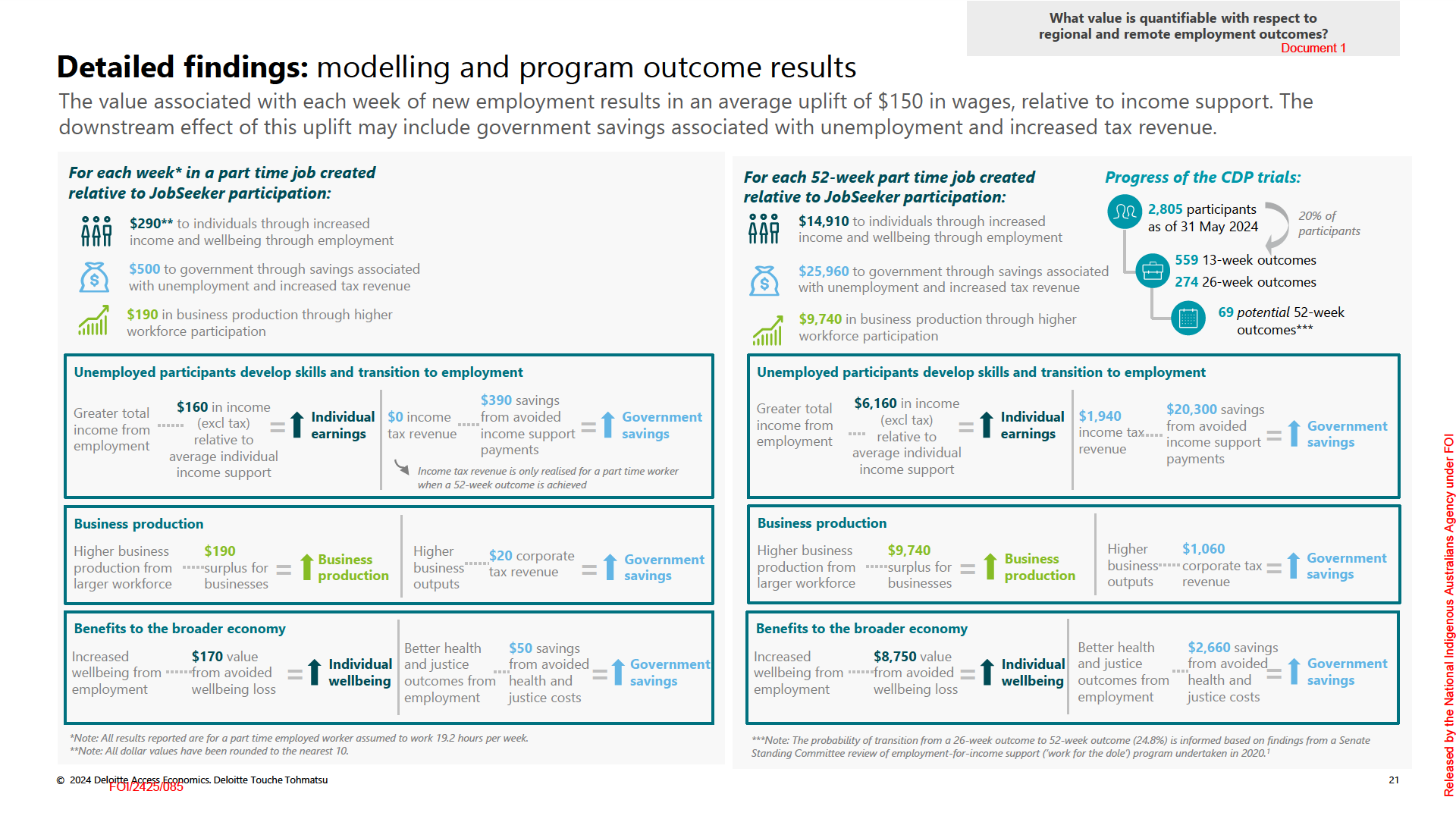
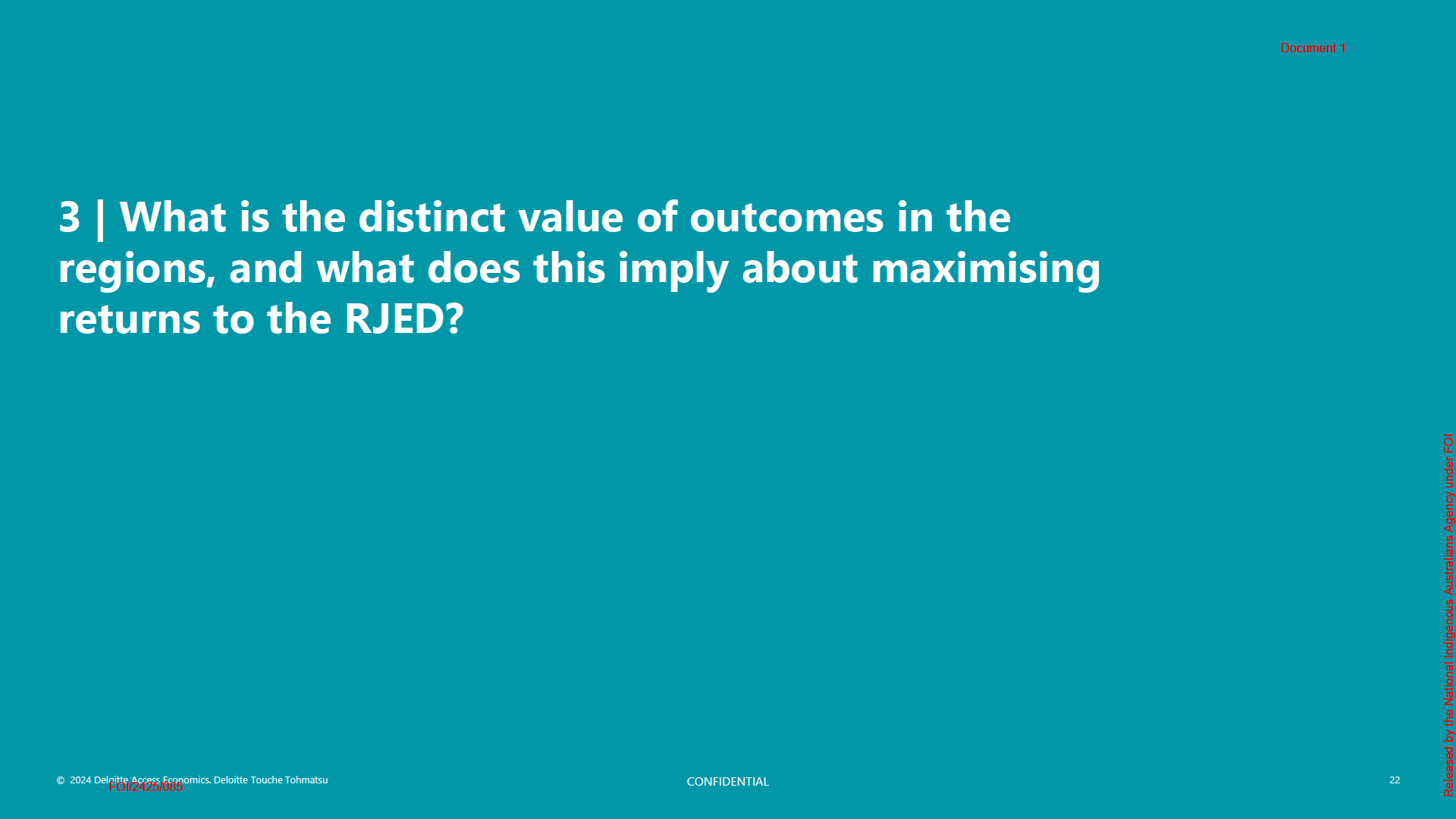
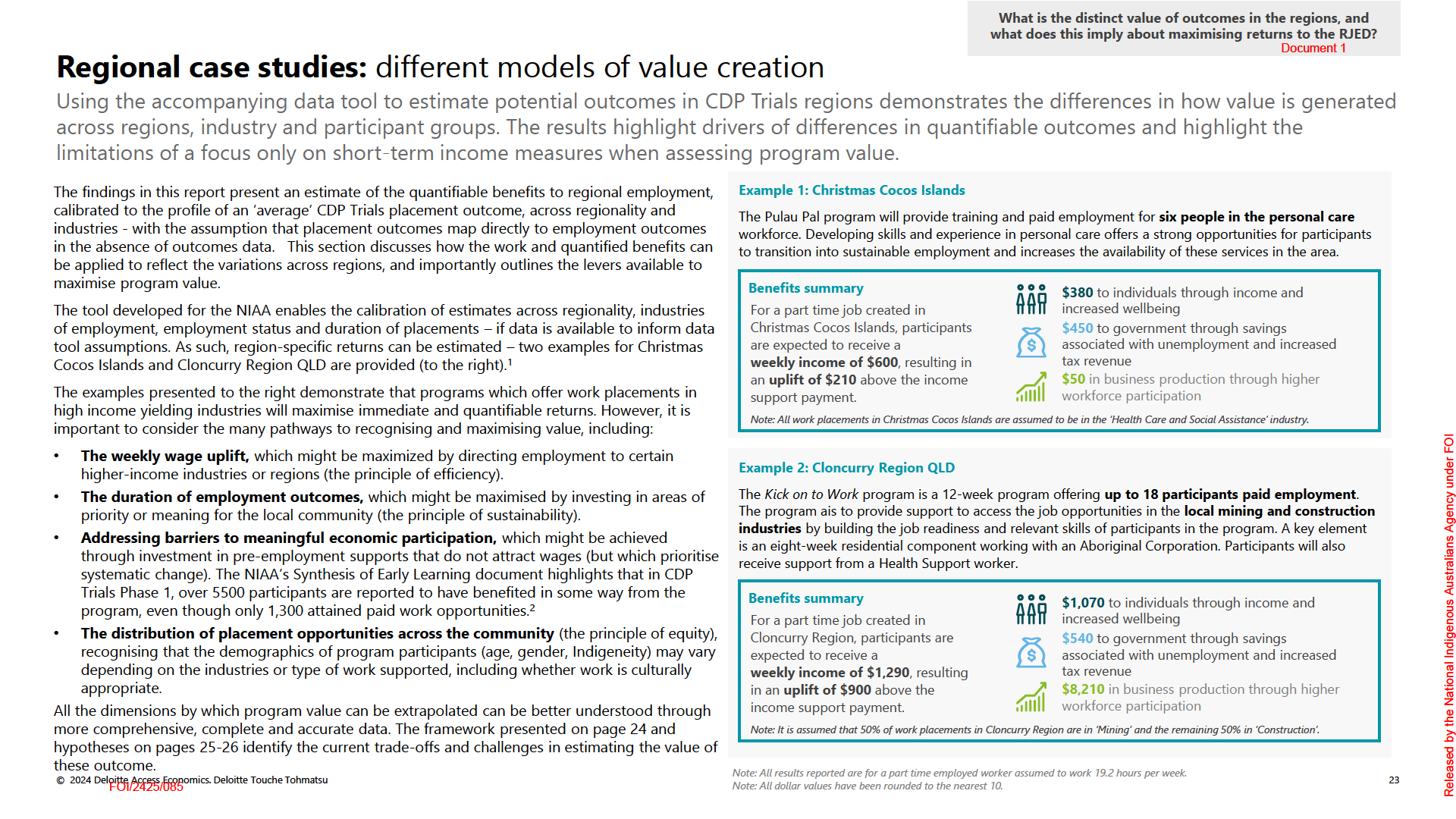
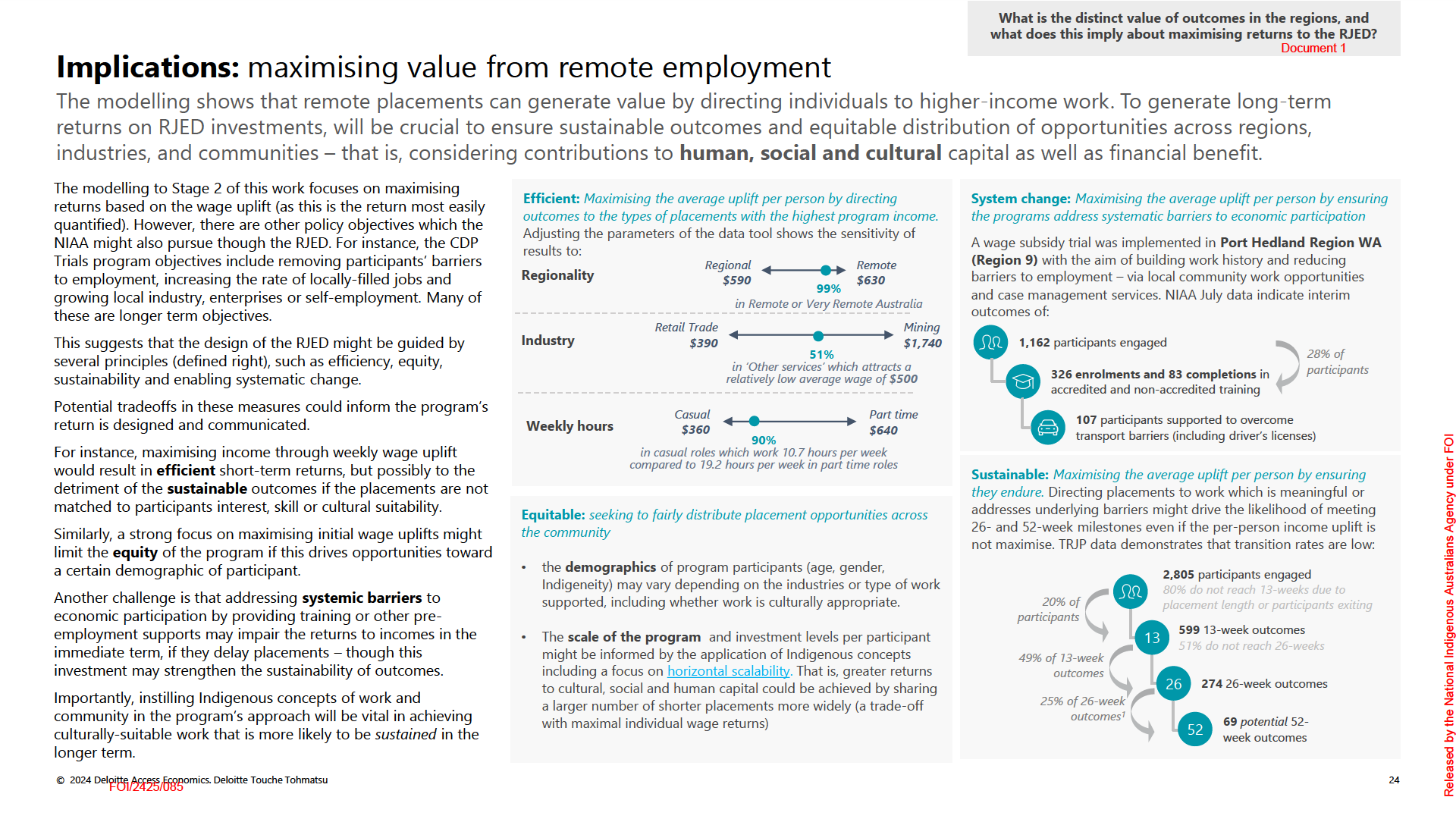
What is the distinct value of outcomes in the regions, and
what does this imply about maximising returns to the RJED?
Provisional conclusions and their implications
Document 1
In estimating the immediately quantifiable value associated with employment placements, the modelling exercise revealed sensitivity to certain
assumptions. The early evidence highlighted opportunities to consider how the ROI of the program could be communicated in the long term.
Insights in this report
A provisional conclusion
Implications for understanding returns
Opportunity for RJED
• The current transition rate of 26-week placements to 52-week
The longer-term value created by the
• There is opportunity to better understand the rates of Stronger evidence will support
outcomes (24.8%) is based on findings from a Senate
trials will depend on the rate of
longer-term outcomes, either by collecting data on
the NIAA to communicate the
Standing Committee review of employment-for-income
transition from 26-week outcomes to
outcomes over time from providers or linking
sustained value of the RJED
support (‘work for the dole’) programs undertaken in 2020.1
enduring and suitable employment.
participant details to DSS administrative dataset
where outcomes endure.
• There is evidence of some displacement and deadweight in
(through PLIDA, for example).
other evaluations of wage subsidies - that is, a risk
• An historical and continuous exercise to estimate the
employment is not enduring.2
likelihood of ongoing outcomes can strengthen the
NIAA’s view of program benefit and sustainability.
• The literature demonstrates that reducing
The consumption and employment
• There is opportunity to better understand the value
Understanding these local
long-term unemployment leads to increased current and
returns associated with placement
associated with the CDP on local economies and
consumption dynamics can
future consumption, and that unemployment rates are higher
outcomes may have a more substantial
businesses. Recognising challenges in data collection
support the NIAA to
in very remote areas
impact in developing the capability of
at the granular level, there is an opportunity for the
communicate how value is
• Regional and remote Australian jurisdictions have the least
regional economies
NIAA to agree on the most regional mechanism to
created through the regional
complex (sophisticated) economies3, with a inverse
track outcomes over time (a combination of Census
employment program and the
relationship between sophistication and consumption
and income tax data, NIAA regional offices data
flow to local industry expected
patterns suggesting that regionally-employed workers are
collection, inputs from program evaluations)
from these investments.
more likely to invest and spend locally.
Agency under FOI
• Data on employment placements focuses on historical
The data from providers and generally
• Notwithstanding the limitations, the exercise of
Stronger evidence will support
outcomes (placements, jobs created, vacancies filled), but
available from the system tends to be
mapping immediate value associated with job
the NIAA to communicate the
there is limited information to understand the likely rates of
insufficient (in terms of informing a
placements does progress the work by (1) clearly
sustained value and to
Australians
transition to sustained employment after the trial concludes.
deeper understanding of community and
hypothesizing what the value could be under the
understand the benefit of
• While some benefit might be inferred through measures of
employment benefit), out of step (not
modelled conditions, and (2) making clear the
programs in
addressing
educational enrolment or outcome, the 13- and 26-week
measuring the activity in the immediate
opportunity to refine the parameters through future
systematic barriers to
Indigenous
outcome measure which is used to inform the initial
system but being consequence of other
data collection.
participation.
modelling framework does not allow coverage of the value of
initiatives), or even potentially wrong
partial outcomes.
(with potential bias to reward signals for
providers, rather than the participant).
by the National
© 2024 Deloitte Access Economics. Deloitte Touche Tohmatsu
25
FOI/2425/085
Released
What is the distinct value of outcomes in the regions, and
what does this imply about maximising returns to the RJED?
Provisional conclusions and their implications
Document 1
In estimating the immediately quantifiable value associated with employment placements, the modelling exercise revealed sensitivity to certain
assumptions. The early evidence highlighted opportunities to consider how the ROI of the program could be communicated in the long term.
Insights in this report
A provisional conclusion
Implications for understanding returns
Opportunity for RJED
• The wage or potential earnings uplift is
The return on investment in immediate
• Including a broader set of benefits in the outcomes
Broader outcomes measures will support the
predictive of a range of downstream economic
wage uplift terms may be limited due to
quantified (to understand the long-term ROI of the
NIAA to communicate the returns to
an
and social benefits for individual, family,
the high rate of casual placements.
program) would require a view of the likely transition
equitable program, and longer-term
community, if and only if the employment is
rates from CDP Trials placements at 13 and 26 weeks
outcomes data will demonstrate the potential
secure and ongoing.
to ongoing employment.
for a
sustainable return.
• The models of employment support offered
• The data tool can be used to dimension some
Visibility of variation in the quantifiable
in the trials vary, and there is identified
regional variation.
benefits across regions might direct attention
limitation in the reliability of data on the
• Recognising challenges in data collection at the
to examples of
different ways value is
industries and occupations associated with
The value of the outcomes is likely to be
granular level, there is an opportunity for the NIAA
shared and generated, in line with
the placements.
broader than that quantified in the
the agree on the most regional mechanism to track
indigenous principles.
• The benefits associated with short-term
immediate wage uplift estimate.
outcomes over time (a combination of Census and
placements or partial outcomes are
income tax data, NIAA regional offices data
challenging to observe, due to the focus on
collection, inputs from program evaluations)
13 and 26-week outcome reporting.
• Some of the RJED employment outcomes
• Data provided by NIAA for a sample of 15 regions
These findings demonstrate the thin markets
might result in displacement of existing
If local human capital is effectively
finds only two instances where a substantial share
where the RJED is implemented – implying a
workers in those roles. However, this
engaged and used to enhance the stock
of jobs created under the CDP Trials would be
focus on maximising value from public
potential outcome aligns with one of the
of produced and financial capital in the
“sustainable without continued funding and
investment rather than an obvious path to
Agency under FOI
policy objectives of replacing FIFO workers
community, the RJED will not only
support”. These sustainable placements appear to
avoiding a commissioning approach. The
with local employment.
redistribute opportunities from FIFO to
local workers but also expand local
be primarily leveraging existing local jobs
capitals framework can be applied to
opportunities through flow-on
(suggesting some degree of displacement), rather
demonstrate these broader dimensions of
Australians
economic benefits.
than unique job creation.
value but must be informed by more
sophisticated data collection.
• The high rate of casual employment
There is a strong likelihood that the result
• There is opportunity to collect data from providers
Stronger evidence on outcomes over time for
placements in the CDP Trials mean that the
at the individual region level will vary
about the hours worked or income earned in casual casual workers might support in
Indigenous
estimated return to employment in the
greatly relative to the on-average
placements.
demonstrating the value of
addressing
program is highly sensitive to the
national modelling result.
• In the modelling, both parameters will be estimated
systematic barriers to participation, even
assumptions about the number of hours
using ABS data which does not always distinguish a
when wage returns are not maximal.
worked.
casual from a part time worker.
by the National
© 2024 Deloitte Access Economics. Deloitte Touche Tohmatsu
26
FOI/2425/085
Released
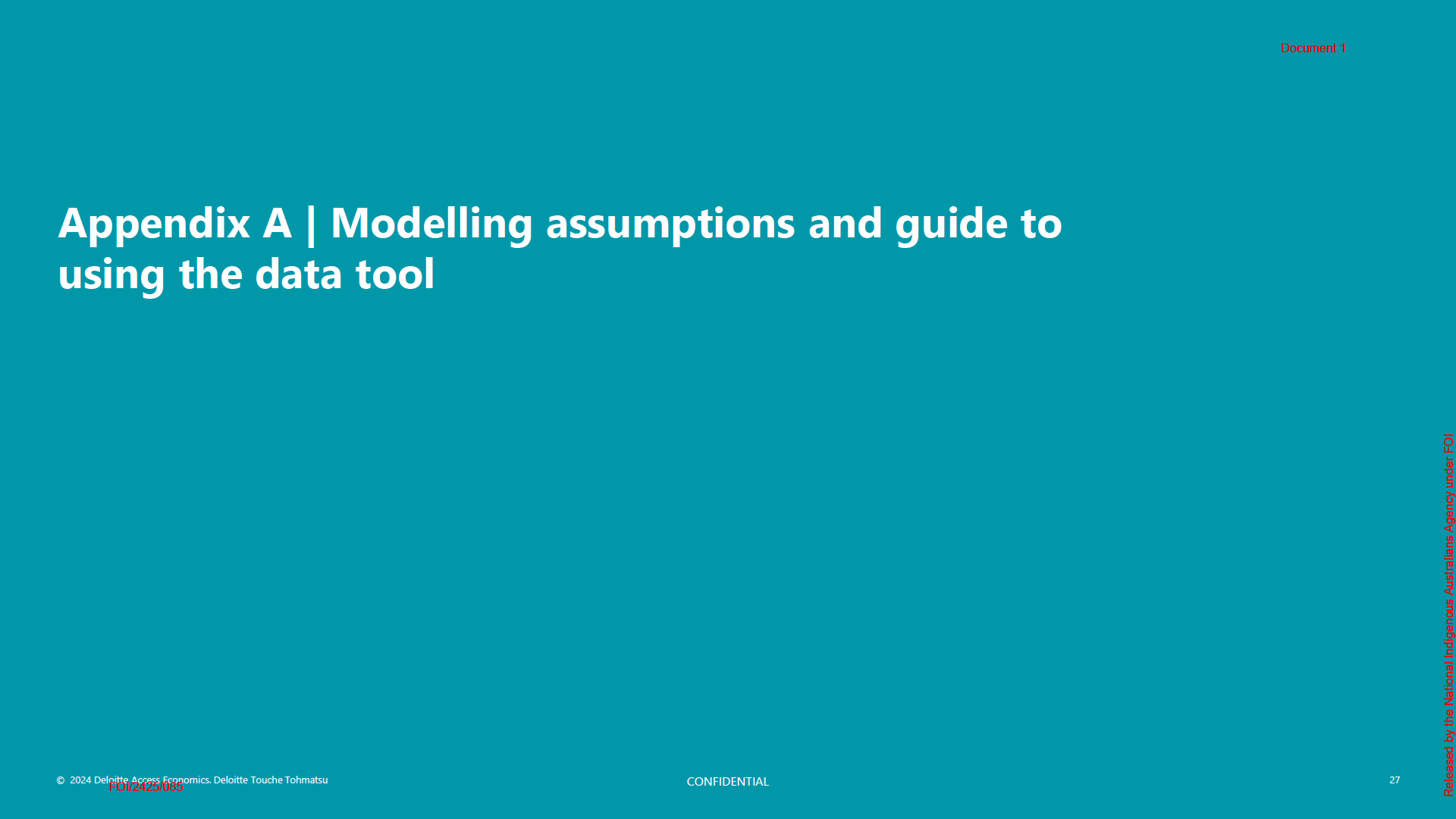
s47G
Agency under FOI
Australians
Indigenous
by the National
© 2024 Deloitte Access Economics. Deloitte Touche Tohmatsu
28
FOI/2425/085
Released
s47G
Agency under FOI
Australians
Indigenous
by the National
© 2024 Deloitte Access Economics. Deloitte Touche Tohmatsu
29
FOI/2425/085
Released
s47G
Agency under FOI
Australians
Indigenous
by the National
© 2024 Deloitte Access Economics. Deloitte Touche Tohmatsu
30
FOI/2425/085
Released
s47G
Agency under FOI
Australians
Indigenous
by the National
© 2024 Deloitte Access Economics. Deloitte Touche Tohmatsu
31
FOI/2425/085
Released
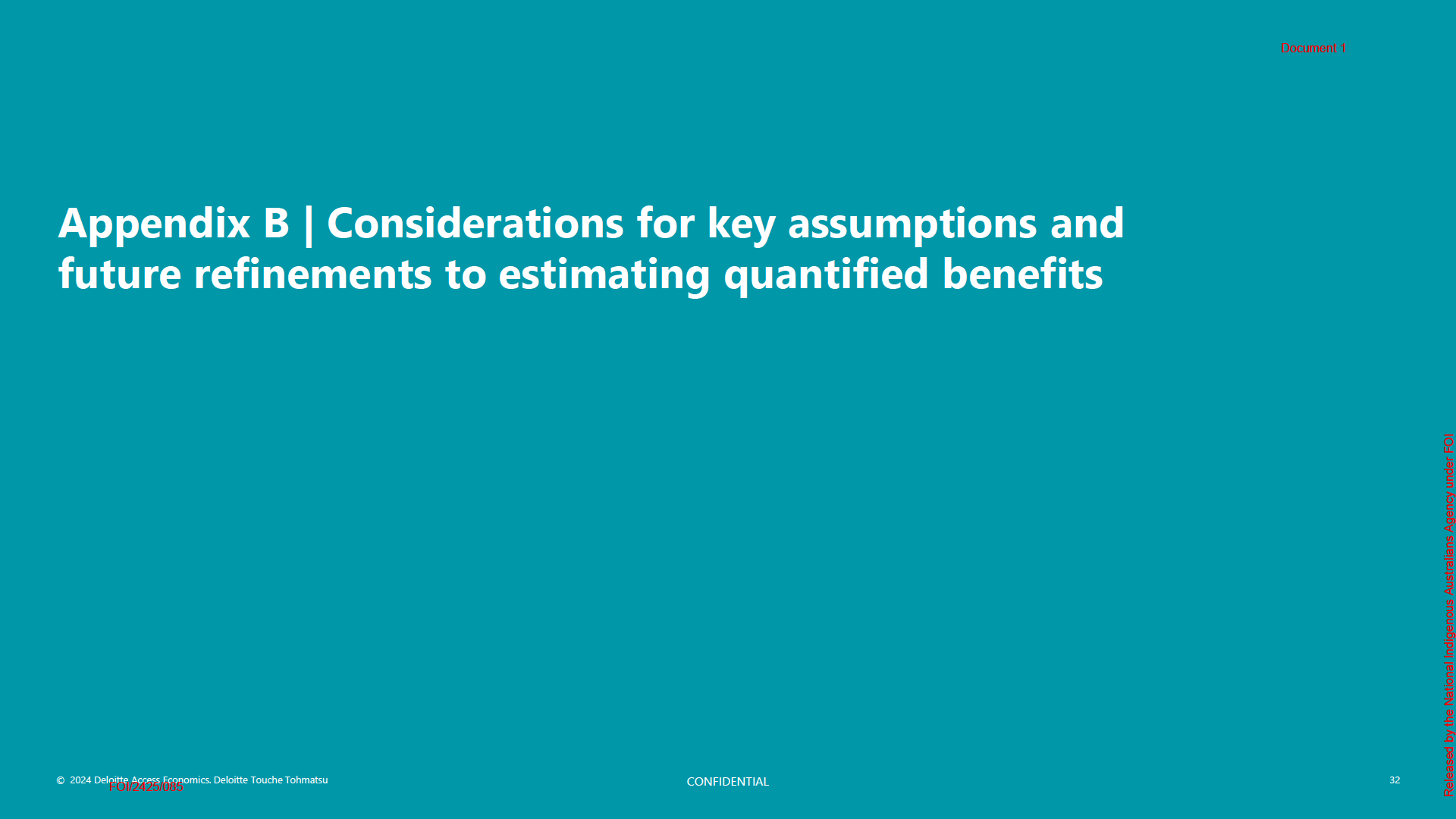
s47G
Agency under FOI
Australians
Indigenous
by the National
© 2024 Deloitte Access Economics. Deloitte Touche Tohmatsu
33
FOI/2425/085
Released

References
Document 1
Page 6 - Key Findings
6. Gabrielle Penrose and Gianni La Cava,
Job Loss, Subjective Expectations and Household Spending, Reserve
1. The Senate,
Education and Employment Legislation Committee, Annual reports (No. 1 of 2020),
Bank of Australia, August 2021, <https://www.rba.gov.au/publications/rdp/2021/2021-
<https://parlinfo.aph.gov.au/parlInfo/download/publications/tabledpapers/d876a0a3-019b-480c-aa38-
08/full.html#section-how-does-unemployment-affect-household-spending>
45aef7025140/upload_pdf/education%20-
7. Deloitte Access Economics, 2023 SROI Evaluation of the NCHP (report commissioned by Community Hubs,
%20annual%20report.pdf;fileType=application%2Fpdf#search=%22publications/tabledpapers/d876a0a3-
March 2024), <https://www.communityhubs.org.au/wp-content/uploads/2024/03/Full-report-2023-SROI-
019b-480c-aa38-45aef7025140%22>
National-Community-Hubs-Program.pdf>
8. M. Gray, B. Hunter, and N. Biddle
, The Economic and Social Benefits of Increasing Indigenous Employment,
Page 8 - Context to this work
Centre for Aboriginal Economic Policy Research, ANU College of Arts & Social Sciences, CAEPR Topical
Issue No. 1/2014, <https://caepr.cass.anu.edu.au/sites/default/files/docs/Topical_Issue_01-
1. Prime Minister of Australia,
Next Steps on Closing the Gap: delivering remote jobs, 2024,
2014_GrayHunterBiddle_EconomicSocialBenefitsIndigenousEmployment_0.pdf>
<https://www.pm.gov.au/media/next-steps-closing-gap-delivering-remote-jobs>
9. I. Mohanty, R. Tanton, Y. Vidyattama, and L. Thurecht,
Estimating the Fiscal Costs of Long-term Jobless
2. National Indigenous Australians Agency,
Job trials: Testing new approaches to remote employment, 2023,
Families in Australia, Australian Journal of Social Issues, vol. 51, no. 1, 2016,
<https://www.niaa.gov.au/our-work/employment-and-economic-development/job-trials-testing-new-
<https://onlinelibrary.wiley.com/doi/epdf/10.1002/j.1839-4655.2016.tb00366.x?saml_referrer.>
approaches-remote-employment>
3. National Indigenous Australians Agency,
Community Development Program (CDP): Trialling Pathways to
Real Jobs, 2023, <https://www.niaa.gov.au/sites/default/files/documents/publications/cdp-trialling-
Page 15 – Detailed findings: the benefits of employment outcomes
pathways-summary-approved-trials-mar-2023.pdf>
1. Government of Australia,
Working Future: The Australian Government’s White Paper on Jobs and
Opportunities, 25 September 2023, <https://treasury.gov.au/employment-whitepaper/final-report.>
Page 14 – Key Findings: the value associated with employment outcomes
2. J. Schmieder, T. von Wachter, and S. Bender
, The Effect of Unemployment Benefits and Nonemployment
Durations on Wages, 2015,
1. Daniel H. Cooper,
The Effect of Unemployment Duration on Future Earnings and Other Outcomes, Federal
<http://www.econ.ucla.edu/tvwachter/papers/SchmiederVonwachterBender_June2015.pdf
>
Reserve Bank of Boston Working Paper No. 13-8, October 10, 2013, <https://ssrn.com/abstract=2366542> 3. Daniel H. Cooper
, The Effect of Unemployment Duration on Future Earnings and Other Outcomes, Federal
2. Natasha Cassidy, Iris Chan, Amelia Gao, and Gabrielle Penrose,
Long-term Unemployment in Australia,
Reserve Bank of Boston Working Paper No. 13-8, October 10, 2013, <https://ssrn.com/abstract=2366542>
Agency under FOI
Reserve Bank of Australia, December 2020,
<https://www.rba.gov.au/publications/bulletin/2020/dec/pdf/long-term-unemployment-in-australia.pdf> 4. Natasha Cassidy, Iris Chan, Amelia Gao, and Gabrielle Penrose,
Long-term Unemployment in Australia,
Reserve Bank of Australia, December 2020,
3. Fiona Macdonald,
Inclusive and Sustainable Employment for Jobseekers Experiencing Disadvantage:
<https://www.rba.gov.au/publications/bulletin/2020/dec/pdf/long-term-unemployment-in-australia.pdf>
Workplace and Employment Barriers, The Australia Institute Centre for Future Work, 2023
,
Australians
<https://futurework.org.au/wp-
5. J. Schmieder, T. von Wachter, and S. Bender
, The Effect of Unemployment Benefits and Nonemployment
content/uploads/sites/2/2023/05/Barriers_to_Sustainable_Emplt_Centre_for_Future_Work-April_2023.pdf>
Durations on Wages, 2015,
<http://www.econ.ucla.edu/tvwachter/papers/SchmiederVonwachterBender_June2015.pdf
>
4. As above
6. Department of Employment and Workplace Relations, Employment Pathway Fund Evaluation: Chapter 2 -
Indigenous
5. M. Gray, B. Hunter, and N. Biddle
, The Economic and Social Benefits of Increasing Indigenous Employment,
Wage Subsidies, FOI Reference D21/527691, 5 April 2023, <https://www.dewr.gov.au/employment-
Centre for Aboriginal Economic Policy Research, ANU College of Arts & Social Sciences, CAEPR Topical
services-evaluations/resources/employment-pathway-fund-evaluation-chapter-2-wage-subsidies>
Issue No. 1/2014, <https://caepr.cass.anu.edu.au/sites/default/files/docs/Topical_Issue_01-
2014_GrayHunterBiddle_EconomicSocialBenefitsIndigenousEmployment_0.pdf>
by the National
© 2024 Deloitte Access Economics. Deloitte Touche Tohmatsu
35
FOI/2425/085
Released
References
Document 1
Page 14 – Detailed findings: the value associated with employment outcomes (cont.)
4. As above
7. Boyd Hunter, Yonatan Dinku, Christian Eva, Francis Markham, and Minda Murra,
Employment and
5. Lateral Economics,
Youth Resilience and Mental Wellbeing: The economic costs of delayed transition to
Indigenous Mental Health, The Australian Institute of Health and Welfare, 2022,
purposeful work (report commissioned for VicHealth), October 2018,
<https://www.indigenousmhspc.gov.au/getattachment/049a59e4-9d01-40f6-a3f4-6f4675eb3dfa/hunter-
<https://www.vichealth.vic.gov.au/sites/default/files/Youth-Resilience-and-Mental-Wellbeing-Economic-
et-al-2022-employment.pdf>
Model.pdf>.’
8. As above
6. S. Lamb and S. Huo,
Counting the Costs of Lost Opportunity in Australian Education, Mitchell Institute
9. Fairfax Media & Lateral Economics
, Fairfax Lateral Economics Index of Australia's Wellbeing: Final Report,
report, No. 02/2017, 2017, <https://content.vu.edu.au/sites/default/files/media/counting-the-costs-of-
February 2014, <https://lateraleconomics.com.au/wp-content/uploads/2014/02/Fairfax-Lateral-
lost-opportunity-in-aus-education-mitchell-institute.pdf.>
Economics-Index-of-Australias-Wellbeing-Final-Report.pdf>
7. O’Donnell, J,
Mapping Social Cohesion 2023, Scanlon Institute, 2023,
10. Frijters, P and Krekel, C,
A Handbook for Wellbeing Policy-Making: History, Theory, Measurement,
<https://scanloninstitute.org.au/sites/default/files/2023-
Implementation and Examples, Oxford University Press, 2021, <https://academic.oup.com/book/39348>
11/2023%20Mapping%20Social%20Cohesion%20Report.pdf>
11. Foster, G,
COVID’s Cohort of Losers: The Intergenerational Burden of the Government’s Coronavirus
8. M. Gray, B. Hunter, and N. Biddle
, The Economic and Social Benefits of Increasing Indigenous Employment,
Response, The Centre for Independent Studies, 2023, <https://www.cis.org.au/wp-
Centre for Aboriginal Economic Policy Research, ANU College of Arts & Social Sciences, CAEPR Topical
content/uploads/2023/06/AP49-covid-burden.pdf>
Issue No. 1/2014, <https://caepr.cass.anu.edu.au/sites/default/files/docs/Topical_Issue_01-
2014_GrayHunterBiddle_EconomicSocialBenefitsIndigenousEmployment_0.pdf>
12. I. Mooi-Reci, M. Wooden, and M. Curry,
Does Having Jobless Parents Damage a Child’s Future?,
Melbourne Institute, No. 04/19, 2019,
9. S. Lamb and S. Huo,
Counting the Costs of Lost Opportunity in Australian Education, Mitchell Institute
<https://melbourneinstitute.unimelb.edu.au/__data/assets/pdf_file/0005/3232868/ri2019n04.pdf>
report, No. 02/2017, 2017, <https://content.vu.edu.au/sites/default/files/media/counting-the-costs-of-
lost-opportunity-in-aus-education-mitchell-institute.pdf.>
13. As above
10. I. Mohanty, R. Tanton, Y. Vidyattama, and L. Thurecht,
Estimating the Fiscal Costs of Long-term Jobless
14. E. Melhuish and J. Gardiner,
The Impact of Non-Economic and Economic Disadvantage in Pre-School
Families in Australia, Australian Journal of Social Issues, vol. 51, no. 1, 2016,
Children in England, NESTA, 2024, <https://www.nesta.org.uk/report/the-impact-of-non-economic-and-
<https://onlinelibrary.wiley.com/doi/epdf/10.1002/j.1839-4655.2016.tb00366.x?saml_referrer.>
economic-disadvantage-in-pre-school-children-in-england/.>
11. The South Australian Centre for Economic Studies,
Disability Employment Landscape Research Report
Agency under FOI
(report commissioned by Disability and Carer Reform Branch Department of Social Services, Precincts and
Page 16 – Detailed findings: the value associated with employment outcomes
Regions), December 2021, <https://www.dss.gov.au/sites/default/files/documents/12_2021/disability-
1. Elizabeth Doery, Lata Satyen, Yin Paradies, Graham Gee, and John W. Toumbourou,
Impact of community-
employment-landscape-research-report.pdf.>
based employment on Aboriginal and Torres Strait Islander wellbeing, aspirations, and resilience, BMC
Australians
Public Health, 2024, <https://bmcpublichealth.biomedcentral.com/articles/10.1186/s12889-024-17909-
Page 19 – Approach: modelling quantifiable benefits
z>
1. Frijters, P and Krekel, C,
A Handbook for Wellbeing Policy-Making: History, Theory, Measurement,
2. M. Gray, B. Hunter, and N. Biddle
, The Economic and Social Benefits of Increasing Indigenous Employment,
Implementation and Examples, Oxford University Press, 2021, <https://academic.oup.com/book/39348>
Indigenous
Centre for Aboriginal Economic Policy Research, ANU College of Arts & Social Sciences, CAEPR Topical
Issue No. 1/2014, <https://caepr.cass.anu.edu.au/sites/default/files/docs/Topical_Issue_01-
2. Foster, G,
COVID’s Cohort of Losers: The Intergenerational Burden of the Government’s Coronavirus
2014_GrayHunterBiddle_EconomicSocialBenefitsIndigenousEmployment_0.pdf>
Response, The Centre for Independent Studies, 2023, <https://www.cis.org.au/wp-
content/uploads/2023/06/AP49-covid-burden.pdf>
3. Gabrielle Penrose and Gianni La Cava,
Job Loss, Subjective Expectations and Household Spending, Reserve
Bank of Australia, August 2021, <https://www.rba.gov.au/publications/rdp/2021/2021-
3. Deloitte Access Economics (2017), updated to 2024 dollar terms; analysis of ABS and HILDA data,
by the National
08/full.html#section-how-does-unemployment-affect-household-spending>
budgetary statements on government investment in public services.
© 2024 Deloitte Access Economics. Deloitte Touche Tohmatsu
36
FOI/2425/085
Released
References
Document 1
Page 21 - Detailed findings: modelling and program outcome results
Page 28 – Appendix A: Data tool assumptions and guidance (1/4)
1. The Senate,
Education and Employment Legislation Committee, Annual reports (No. 1 of 2020),
1. Services Australia,
JobSeeker Payment, 2024, <https://www.servicesaustralia.gov.au/how-much-jobseeker-
<https://parlinfo.aph.gov.au/parlInfo/download/publications/tabledpapers/d876a0a3-019b-480c-aa38-
payment-you-can-get?context=51411>
45aef7025140/upload_pdf/education%20-
2. Services Australia,
Remote Area Allowance, 2024, <https://www.servicesaustralia.gov.au/how-much-
%20annual%20report.pdf;fileType=application%2Fpdf#search=%22publications/tabledpapers/d876a0a3-
remote-area-allowance-you-can-get?context=22571#a2>
019b-480c-aa38-45aef7025140%22>
Page 29 - Appendix A: Data tool assumptions and guidance (2/4)
Page 23 – Regional case studies
1. Senate Standing Committee on Education and Employment, Questions on Notice, Supplementary Budget
1. The regional case studies presented on this page make assumptions about the number of placements
Estimates 2019-2020: Dept of Employment, Skills, Small and Family Business Question No. EMSQ19-
across industries using descriptions provided in the NIAA’s summary of approved hase 1 trials and are
001227, 2020
designed to be illustrative only. Actual data are used for the Region 9 case study on page 25.
National Indigenous Australian Agency,
Community Development Program: Trialling Pathways to Real
Jobs - Summary of Approved Trials (March 2023)
Page 30 – Appendix A: Data tool assumptions and guidance (3/4):
<https://www.niaa.gov.au/sites/default/files/documents/publications/cdp-trialling-pathways-summary-
1. Australian Bureau of Statistics,
Australian National Accounts: Input-Output Tables, 2021
approved-trials-mar-2023.pdf>
<https://www.abs.gov.au/statistics/economy/national-accounts/australian-national-accounts-input-
2. National Indigenous Australians Agency,
Community Development Program: Phase 1 Trials Synthesis of
output-tables/latest-release>
Early Learnings from ‘Trialling Pathways to Real Jobs’ (April 2024)
2. As above
<https://www.niaa.gov.au/sites/default/files/documents/2024-04/cdp-synthesis-of-early-learnings-
3. Deloitte Access Economics (2017), updated to 2024 dollar terms; analysis of ABS and HILDA data,
tprj.pdf>
budgetary statements on government investment in public services.
Page 25 – Provisional conclusions and their implications
Page 31 - Appendix A: Data tool assumptions and guidance (4/4):
1. The Senate,
Education and Employment Legislation Committee, Annual reports (No. 1 of 2020),
Agency under FOI
1. Frijters, P and Krekel, C,
A Handbook for Wellbeing Policy-Making: History, Theory, Measurement,
<https://parlinfo.aph.gov.au/parlInfo/download/publications/tabledpapers/d876a0a3-019b-480c-aa38-
Implementation and Examples, Oxford University Press, 2021, <https://academic.oup.com/book/39348>
45aef7025140/upload_pdf/education%20-
%20annual%20report.pdf;fileType=application%2Fpdf#search=%22publications/tabledpapers/d876a0a3-
2. Foster, G,
COVID’s Cohort of Losers: The Intergenerational Burden of the Government’s Coronavirus
019b-480c-aa38-45aef7025140%22>
Response, The Centre for Independent Studies, 2023, <https://www.cis.org.au/wp-
Australians
content/uploads/2023/06/AP49-covid-burden.pdf>
2. Department of Employment and Workplace Relations
, Employment Pathway Fund Evaluation: Chapter 2 -
Wage Subsidies, FOI Reference D21/527691, 5 April 2023, <https://www.dewr.gov.au/employment-
3. Australian Taxation Office (ATO),
Tax rates – Australian resident 2023-24, 2024,
services-evaluations/resources/employment-pathway-fund-evaluation-chapter-2-wage-subsidies>
<https://www.ato.gov.au/tax-rates-and-codes/tax-rates-australian-residents>
Indigenous
3. Beale, G,
Economic Complexity of Australian States, 2023,
<https://blogs.flinders.edu.au/aiti/2023/10/11/economic-complexity-australian-states/>
by the National
© 2024 Deloitte Access Economics. Deloitte Touche Tohmatsu
37
FOI/2425/085
Released
Document 1
General use restriction
This report is prepared solely for the internal use of National Indigenous Australians Agency (NIAA). This report is not intended to and should not be used or relied upon
by anyone else and we accept no duty of care to any other person or entity. The report has been prepared for the purpose of set out in our work order. You should not
refer to or use our name or the advice for any other purpose.
Deloitte refers to one or more of Deloitte Touche Tohmatsu imited (“DTT ”), its global network of member firms, and their related entities (collectively, the “Deloitte
organization”). DTT (also referred to as “Deloitte Global”) and each of its member firms and related entities are legally separate and independent entities, which cannot
obligate or bind each other in respect of third parties. DTTL and each DTTL member firm and related entity is liable only for its own acts and omissions, and not those of
each other. DTTL does not provide services to clients. Please see www.deloitte.com/about to learn more.
Agency under FOI
Deloitte Asia Pacific Limited is a company limited by guarantee and a member firm of DTTL. Members of Deloitte Asia Pacific Limited and their related entities, each of
which is a separate and independent legal entity, provide services from more than 100 cities across the region, including Auckland, Bangkok, Beijing, Bengaluru, Hanoi,
Hong Kong, Jakarta, Kuala Lumpur, Manila, Melbourne, Mumbai, New Delhi, Osaka, Seoul, Shanghai, Singapore, Sydney, Taipei and Tokyo.
Australians
This communication contains general information only, and none of DTTL, its global network of member firms or their related entities is, by means of this communication,
rendering professional advice or services. Before making any decision or taking any action that may affect your finances or your business, you should consult a qualified
professional adviser.
Indigenous
No representations, warranties or undertakings (express or implied) are given as to the accuracy or completeness of the information in this communication, and none of
DTTL, its member firms, related entities, employees or agents shall be liable or responsible for any loss or damage whatsoever arising directly or indirectly in connection
with any person relying on this communication.
by the National
© 2024 Deloitte Access Economics. Deloitte Touche Tohmatsu
CONFIDENTIAL
FOI/2425/085
Released






















